Decide if You Are Ready for SAFe
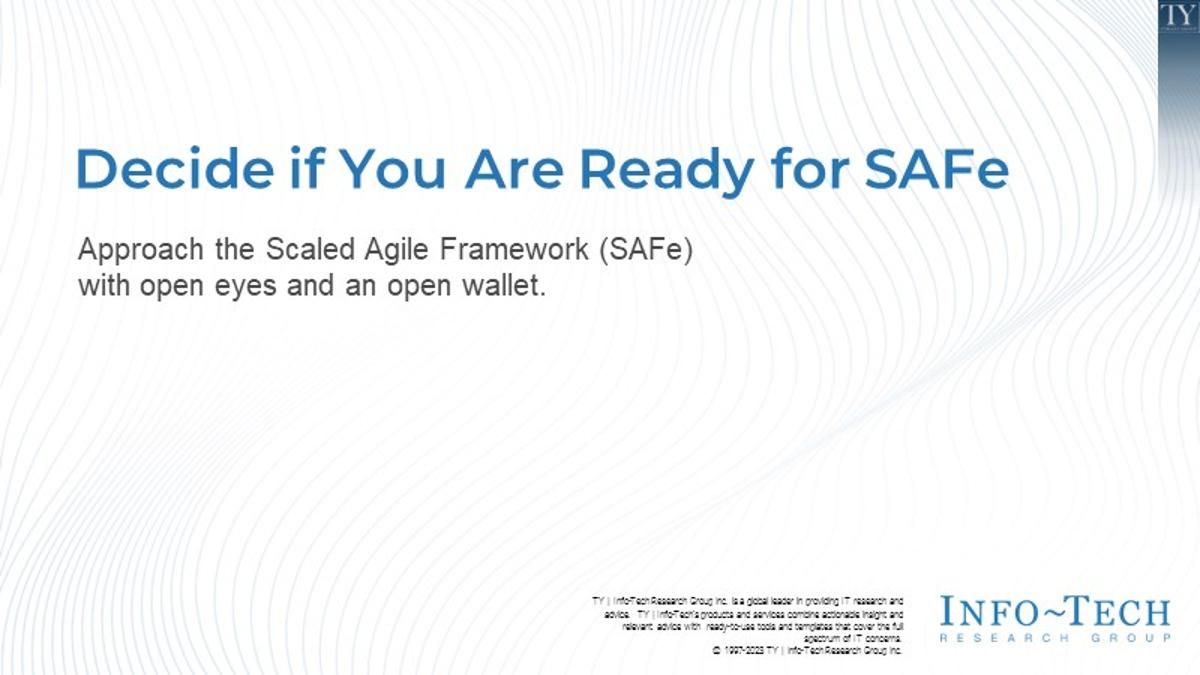
- Complex application landscapes require delivery teams to work together and coordinate changes across multiple product lines and releases.
- Leadership wants to balance strategic goals with localized prioritization of changes.
- Traditional methodologies are not well suited to support enterprise agility: Scrum doesn’t scale easily, and Waterfall is too slow and risky.
Our Advice
Critical Insight
SAFe’s popularity is largely due to its structural resemblance to enterprise portfolio and project planning with top-down prioritization and decision making. This directly conflicts with Agile’s purpose and principles of empowerment and agility.
- Poor culture, processes, governance, and leadership will disrupt any methodology. Many drivers for SAFe could be solved by improving and standardizing development and release management within current methodologies.
- Few organizations are capable or should be applying a pure SAFe framework. Successful organizations have adopted and modified SAFe frameworks to best fit their needs, teams, value streams, and maturity.
Impact and Result
- Start with a clear understanding of your needs, constraints, goals, and culture.
- Start with an Agile readiness assessment. Agile is core to value realization.
- Take the time to determine your drivers and goals.
- If SAFe is right for you, selecting the right implementation partner is key.
- Plan SAFe as a long-term enterprise cultural transformation requiring changes at all levels.
Decide if You Are Ready for SAFe Research & Tools
Besides the small introduction, subscribers and consulting clients within this management domain have access to:
1. Decide if You Are Ready for SAFe Storyboard – Research to help you understand where SAFe fits into delivery methodologies and determine if SAFe is right for your organization.
This deck will guide you to define your primary drivers for SAFe, assess your Agile readiness, define enablers and blockers, estimate implementation risk, and start your SAFe implementation plan.
- Decide if You Are Ready for SAFe Storyboard
2. Scaled Agile Readiness Assessment – A tool to conduct an Agile readiness survey.
Start your journey with a clear understanding about the level of Agile and product maturity throughout the organization. Each area that lacks strength should be evaluated further and added to your journey map.
- Scaled Agile Readiness Assessment
3. SAFe Transformation Playbook – A template to build a change management plan to guide your transition.
Define clear ownership for every critical step.
- SAFe Transformation Playbook
Workshop: Decide if You Are Ready for SAFe
Workshops offer an easy way to accelerate your project. If you are unable to do the project yourself, and a Guided Implementation isn't enough, we offer low-cost delivery of our project workshops. We take you through every phase of your project and ensure that you have a roadmap in place to complete your project successfully.
1 Understand where SAFe fits into delivery methodologies and SDLCs
The Purpose
Understand what is driving your proposed SAFe transformation and if it is the right framework for your organization.
Key Benefits Achieved
Better understanding of your scaled agile needs and drivers
Activities
1.1 Define your primary drivers for SAFe.
1.2 Create your own list of pros and cons of SAFe.
Outputs
List of primary drivers for SAFe
List of pros and cons of SAFe
2 Determine if you are ready for SAFe
The Purpose
Identify factors influencing a SAFe implementation and ensure teams are aware and prepared.
Key Benefits Achieved
Starting understanding of your organization’s readiness to implement a SAFe framework
Activities
2.1 Assess your Agile readiness.
2.2 Define enablers and blockers of scaling Agile delivery.
2.3 Estimate your SAFe implementation risk.
2.4 Start your SAFe implementation plan.
Outputs
Agile readiness assessment results
List of enablers and blockers of scaling Agile delivery
Estimated SAFe implementation risk
High-level SAFe implementation plan template
Further reading
Decide if You Are Ready for SAFe
Approach the Scaled Agile Framework (SAFe) with open eyes and an open wallet.
Analyst Perspective
Ensure that SAFe is the right move before committing.
Waterfall is dead. Or obsolete at the very least.
Organizations cannot wait months or years for product, service, application, and process changes. They need to embrace business agility to respond to opportunities more quickly and deliver value sooner. Agile established values and principles that have promoted smaller cycle times, greater connections between teams, improved return on investment (ROI) prioritization, and improved team empowerment.
Where organizations continue to struggle is matching localized Scrum teams with enterprise initiatives. This struggle is compounded by legacy executive planning cycles, which undermine Agile team authority. SAFe has provided a series of frameworks to help organizations deal with these issues. It combines enterprise planning and alignment with cross-team collaboration.
Don't rely on popularity or marketing to make your scaled Agile decision. SAFe is a highly disruptive transformation, and it requires extensive training, coaching, process changes, and time to implement. Without the culture shift to an Agile mindset at all levels, SAFe becomes a mirror of Waterfall processes dressed in SAFe names. Furthermore, SAFe itself will not fix problems with communication, requirements, development, testing, release, support, or governance. You will still need to fix these problems within the SAFe framework to be successful.

Hans Eckman
Principal Research Director, Applications Delivery and Management
Info-Tech Research Group
Executive Summary
| Your Challenge | Common Obstacles | Info-Tech's Approach |
|
|
Start with a clear understanding of your needs, constraints, goals, and culture.
|
Info-Tech Insight
SAFe is a highly disruptive enterprise transformation, and it won't solve your organizational delivery challenges by itself. Start with an open mind, and understand what is needed to support a multi-year cultural transition. Decide how far and how fast you are willing to transform, and make sure that you have the right transformation and coaching partner in place. There is no right software development lifecycle (SDLC) or methodology. Find or create the methodology that best aligns to your needs and goals.
Agile's Four Core Values
"...while there is value in the items on the right, we value the items on the left more."
- The Agile Manifesto
STOP! If you're not Agile, don't start with SAFe.
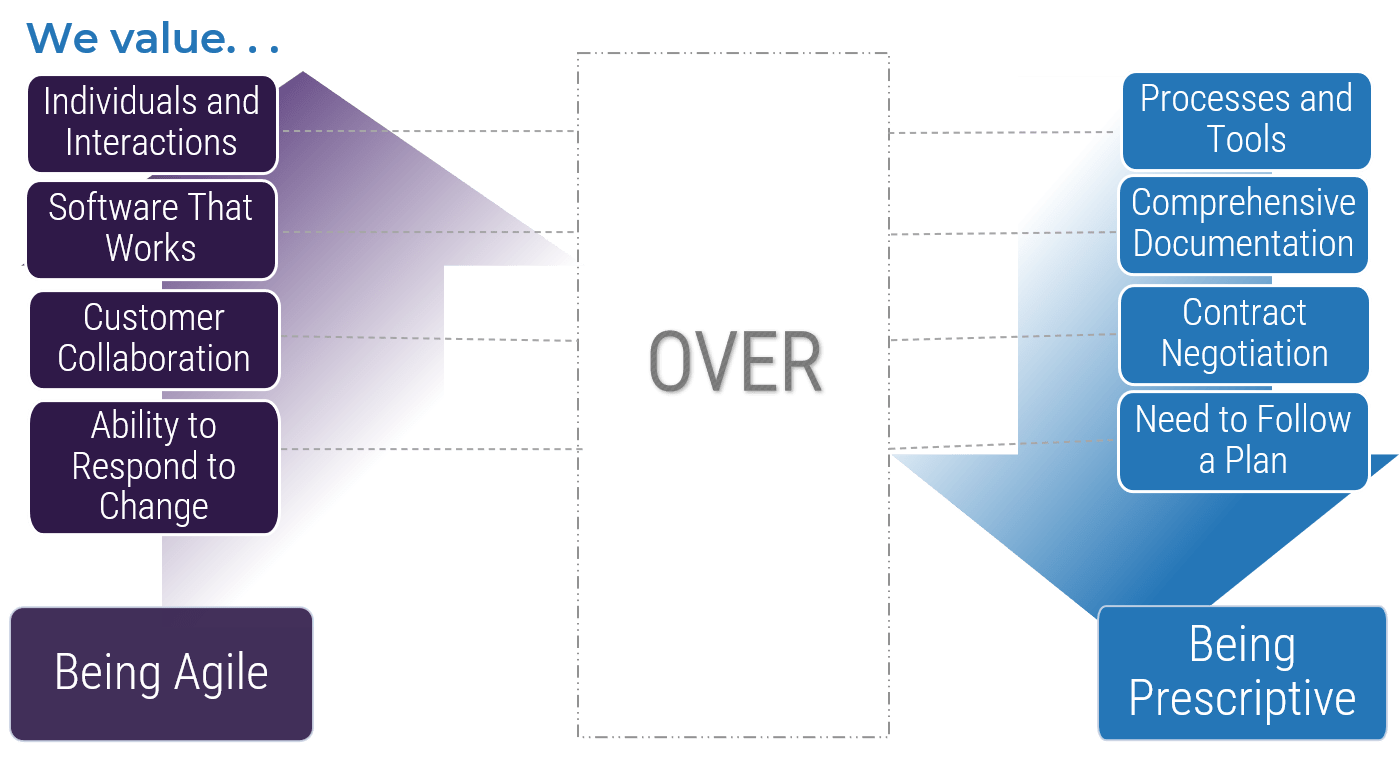
Successful SAFe requires an Agile mindset at all levels.
Be aware of common myths around Agile and SAFe
SAFe does not...
1...solve development and communication issues.
2...ensure that you will finish requirements faster.
3...mean that you do not need planning and documentation.
"Without proper planning, organizations can start throwing more resources at the work, which spirals into the classic Waterfall issues of managing by schedule."
– Kristen Morton, Associate Implementation Architect,
OneShield Inc. (Info-Tech Interview)
Info-Tech Insight
Poor culture, processes, governance, and leadership will disrupt any methodology. Many drivers for SAFe could be solved by improving and standardizing development and release management within current methodologies.
Review the drivers that are motivating your organization to adopt and scale Agile practices
Functional groups have their own drivers to adopt Agile development processes, practices, and techniques (e.g. to improve collaboration, decrease churn, or increase automation). Their buy-in to scaling Agile is just as important as the buy-in of stakeholders.
If a group's specific needs and drivers are not addressed, its members may develop negative sentiments toward Agile development. These negative sentiments can affect their ability to see the benefits of Agile, and they may return to their old habits once the opportunity arises.
It is important to find opportunities in which both business objectives and functional group drivers can be achieved by scaling Agile development. This can motivate teams to continuously improve and adhere to the new environment, and it will maintain business buy-in. It can also be used to justify activities that specifically address functional group drivers.
Examples of Motivating Drivers for Scaling Agile
- Improve artifact handoffs between development and operations.
- Increase collaboration among development teams.
- Reveal architectural and system risks early.
- Expedite the feedback loop from support.
- Improve capacity management.
- Support development process innovation.
- Create a safe environment to discuss concerns.
- Optimize value streams.
- Increase team engagement and comradery.
Don't start with scaled Agile!
Scaling Agile is a way to optimize product management and product delivery in application lifecycle management practices. Do not try to start with SAFe when the components are not yet in place.
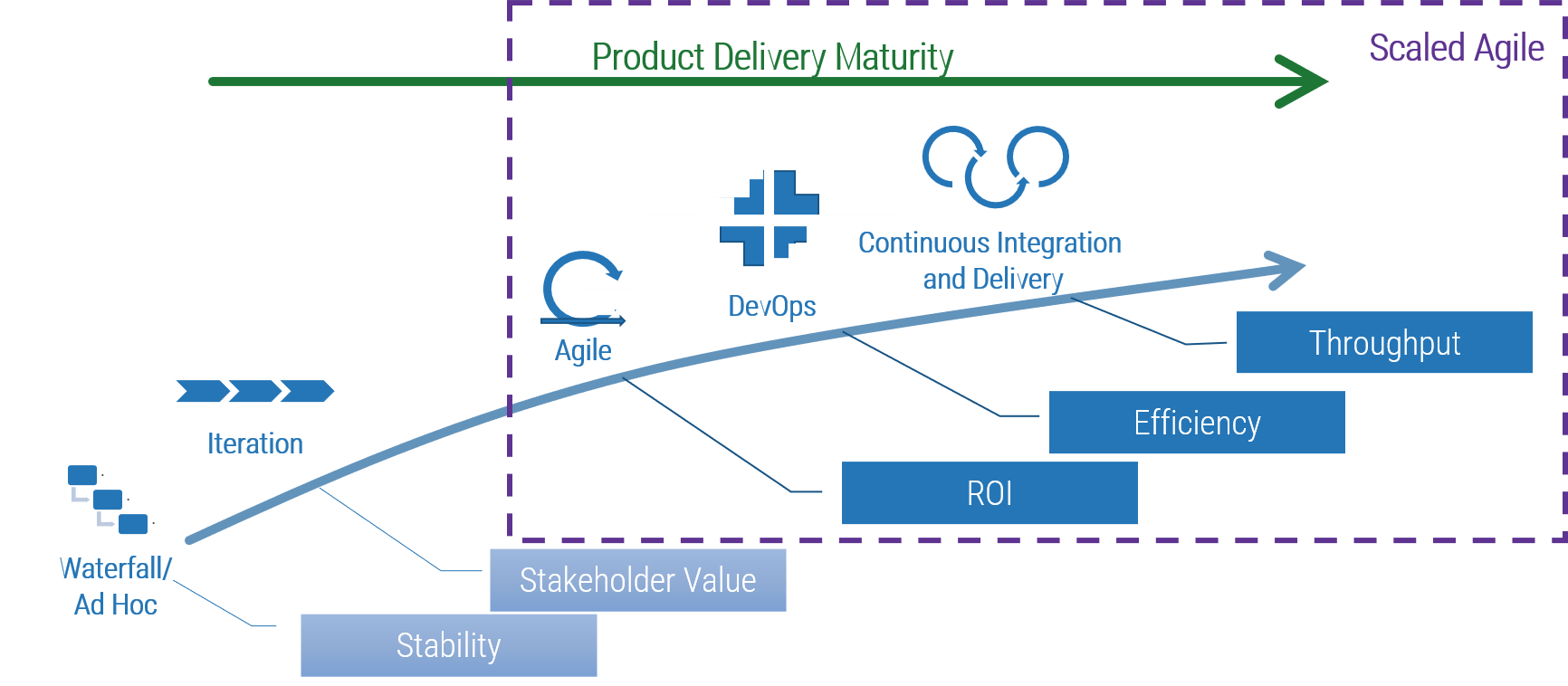

Scale Agile delivery to improve cross-functional dependencies and releases
Top Business Concerns When Scaling Agile
1 Organizational Culture: The current culture may not support team empowerment, learning from failure, and other Agile principles. SAFe also allows top-down decisions to persist.
2 Executive Support: Executives may not dedicate resources, time, and effort into removing obstacles to scaling Agile because of lack of business buy-in.
3 Team Coordination: Current collaboration structures may not enable teams and stakeholders to share information freely and integrate workflows easily.
4 Business Misalignment: Business vision and objectives may be miscommunicated early in development, risking poorly planned and designed initiatives and low-quality products.
Extending collaboration is the key to success.
Uniting stakeholders and development into a single body is the key to success. Assess the internal and external communication flow and define processes for planning and tracking work so that everyone is aware of how to integrate, communicate, and collaborate.
The goal is to enable faster reaction to customer needs, shorter release cycles, and improved visibility of the project's progress with cross-functional and diverse conversations.
Advantages of successful SAFe implementations
Once SAFe is complete and operational, organizations have seen measurable benefits:
- Multiple frameworks to support different levels of SAFe usage
- Deliberate and consistent planning and coordination
- Coordinating dependencies within value streams
- Reduced time to delivery
- Focus on customers and end users
- Alignment to business goals and value streams
- Increased employee engagement
Sources: TechBeacon, 2019; Medium, 2020; "Benefits," Scaled Agile, 2023;
"Pros and Cons," PremierAgile, n.d.; "Scaling Agile Challenges," PremierAgile, n.d.
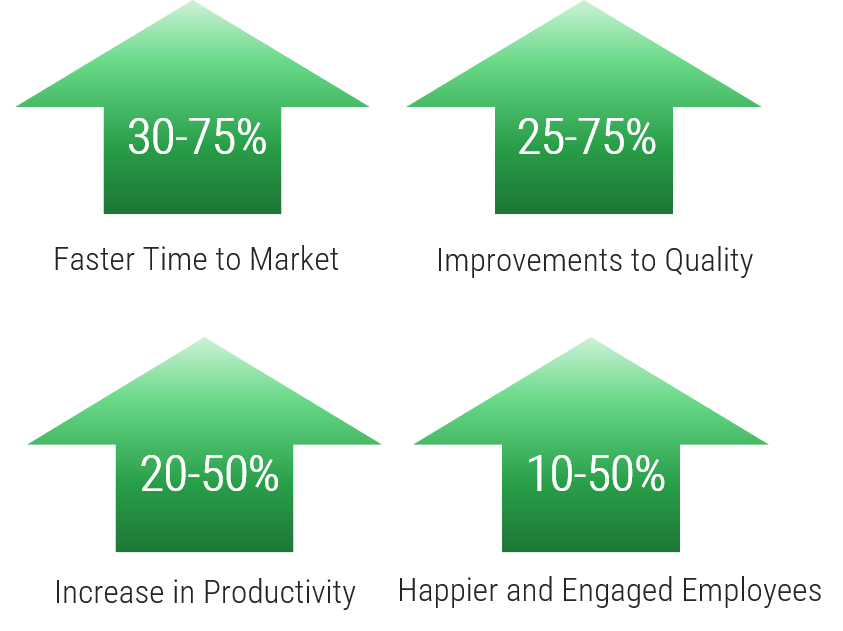
Source: "Benefits," Scaled Agile, 2023
Recognize the difference between Scrum teams and the Scaled Agile Framework (SAFe)
SAFe provides a framework that aligns Scrum teams into coordinated release trains driven by top-down prioritization.
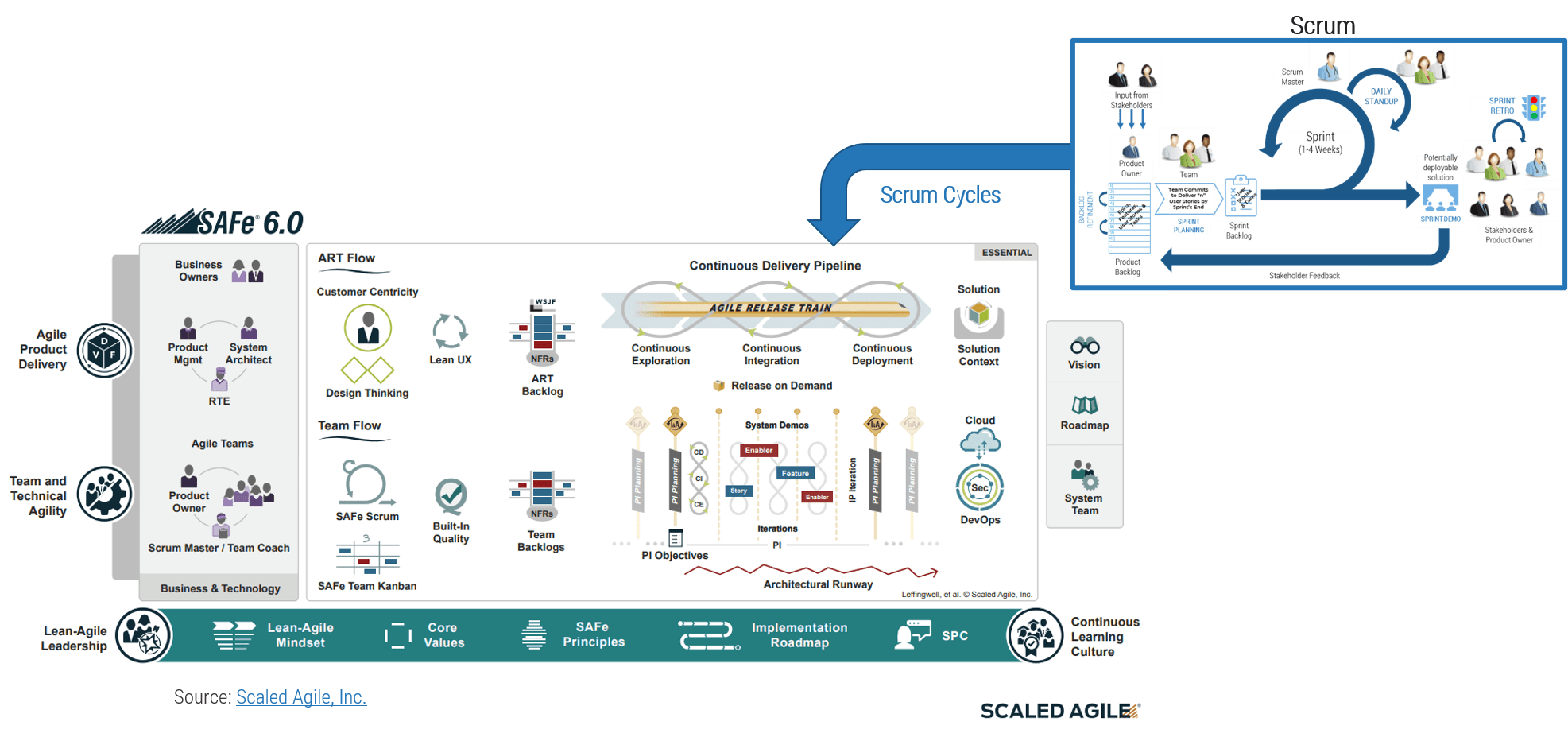
Develop Your Agile Approach for a Successful Transformation
Source: Scaled Agile, Inc.
Info-Tech's IT Management & Governance Framework
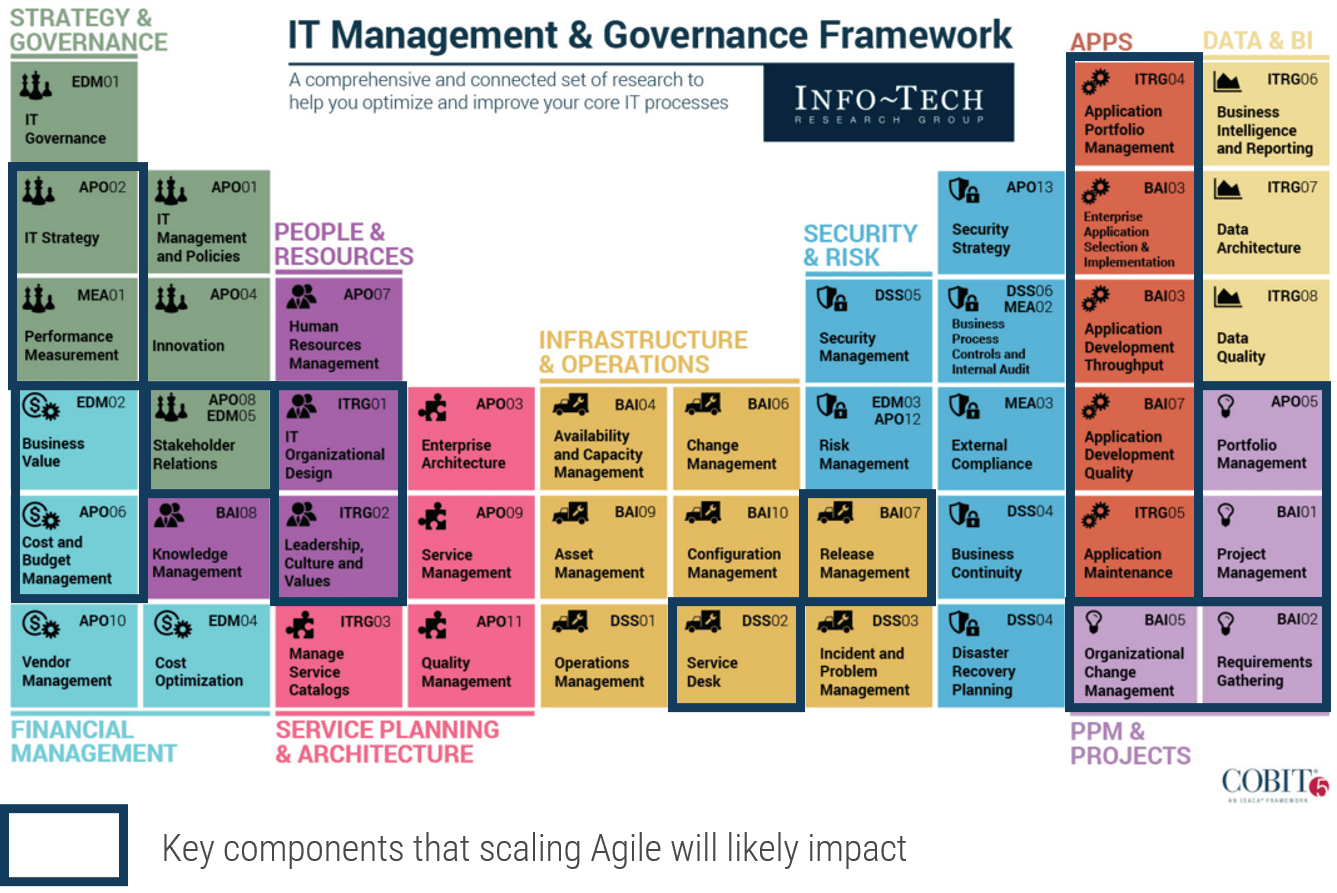
Info-Tech Insight
SAFe is an enterprise, culture, and process transformation that impacts all IT services. Some areas of Info-Tech's IT Management & Governance Framework have higher impacts and require special attention. Plan to include transformation support for each of these topics during your SAFe implementation. SAFe will not fix broken processes on its own.
Without adopting an Agile mindset, SAFe becomes Waterfall with SAFe terminology
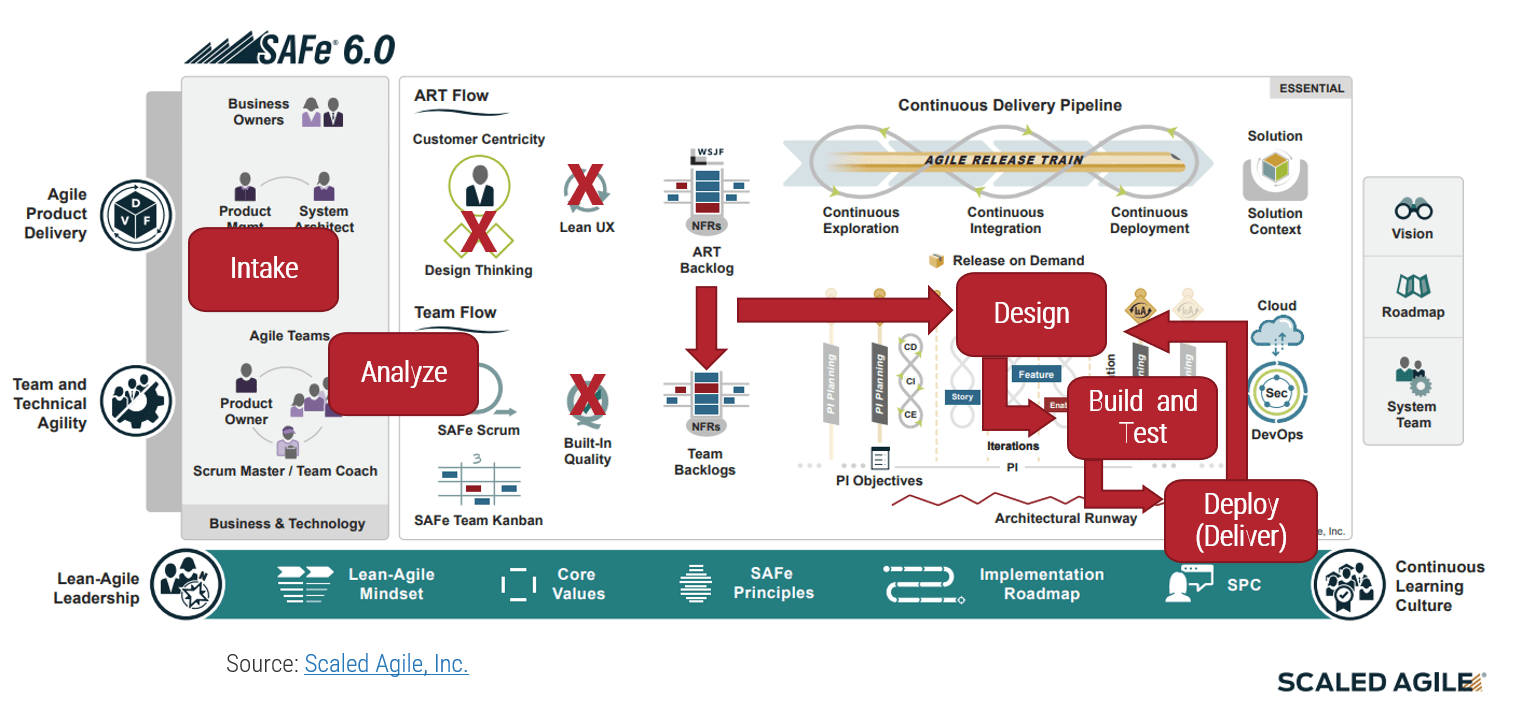
Source: Scaled Agile, Inc.
Info-Tech Insight
When first implementing SAFe, organizations reproduce their organizational design and Waterfall delivery structures with SAFe terms:
- Delivery Manager = Release Train Engineer
- Stakeholder/Sponsor = Product Manager
- Release = Release Train
- Project/Program = Project or Portfolio
SAFe isn't without risks or challenges
Risks and Causes of Failed SAFe Transformations
- SAFe conflicts with legacy cultures and delivery processes.
- SAFe promotes continued top-down decisions, undermining team empowerment.
- Scaled product families are required to define proper value streams.
- Team empowerment and autonomy are reduced.
- SAFe activities are poorly executed.
- There are high training and coaching costs.
- Implementation takes a long time.
- End-to-end delivery management tools aligned to SAFe are required.
- Legacy delivery challenges are not specifically solved with SAFe.
- SAFe is designed to work for large-scale development teams.
Challenges
- Adjusting to a new set of terms for common roles, processes, and activities
- Executing planning cycles
- Defining features and epics at the right level
- Completing adequate requirements
- Defining value streams
- Coordinating releases and release trains
- Providing consistent quality
Sources: TechBeacon, 2019; Medium, 2020; "Benefits," Scaled Agile, 2023;
"Pros and Cons," PremierAgile, n.d.; "Scaling Agile Challenges," PremierAgile, n.d.
Focus on your core competencies instead
Before undertaking an enterprise transformation, consider improving the underlying processes that will need to be fixed anyway. Fixing these areas while implementing SAFe compounds the effort and disruption.
Product Delivery
- Agile/DevOps Research Center
- Develop Your Agile Approach for a Successful Transformation
- Understand Agile fundamentals, principles, and practices so you can apply them effectively in your organization.
- Implement DevOps Practices That Work
- Streamline business value delivery through the strategic adoption of DevOps practices.
Product Management
- Product Lifecycle Management Research Center
- Make the Case for Product Delivery
- Align your organization on the practices to deliver what matters most.
- Deliver on Your Digital Product Vision
- Build a product vision your organization can take from strategy through execution.
- Deliver Digital Products at Scale
- Deliver value at the scale of your organization through defining enterprise product families.
- Introduce Program Management to Your Organization
- Use programs to align projects to your strategic goals.
- Optimize IT Project Intake, Approval, and Prioritization
- Decide which IT projects to approve and when to start them.
- Manage Requirements in an Agile Environment
- Agile and requirements management are complementary, not competitors.
- Build a Software Quality Assurance Program
- Build quality into every step of your SDLC.
- Automate Testing to Get More Done
- Drive software delivery throughput and quality confidence by extending your automation test coverage.
- Application Portfolio Management Foundations
- Ensure your application portfolio delivers the best possible return on investment.
"But big-bang transitions are hard. They require total leadership commitment, a receptive culture, enough talented and experienced agile practitioners to staff hundreds of teams without depleting other capabilities, and highly prescriptive instruction manuals to align everyone's approach."
– "Agile at Scale," Harvard Business Review
Insight Summary
Overarching insight
SAFe is a highly disruptive enterprise transformation, and it will not solve your organizational delivery challenges by itself. Start with an open mind, and understand what is needed to support a multi-year cultural transition. Decide how far and fast you are willing to transform and make sure that you have the right transformation and coaching partner in place.
SAFe conflicts with core Agile principles.
The popularity of SAFe is largely due to its structural resemblance to enterprise portfolio and project planning with top-down prioritization and decision-making. This directly conflicts with Agile's purpose and principles of empowerment and agility.
SAFe and Agile will not solve enterprise delivery challenges.
Poor culture, processes, governance, and leadership will disrupt any methodology. Many issues with drivers for SAFe could be solved by improving development and release management within current methodologies.
Most organizations should not be using a pure SAFe framework
Few organizations are capable of, or should be, applying a pure SAFe framework. Successful organizations have adopted and modified SAFe frameworks to best fit their needs, teams, value streams, and maturity.
Without an Agile mindset, SAFe will be executed as Waterfall stages using SAFe terminology.
Groups that "Do Agile" are not likely to embrace the behavioral changes needed to make any scaled framework effective. SAFe becomes a series of Waterfall PIs using SAFe terminology.
Your transformation does not start with SAFe.
Start your transition to scaled Agile with a maturity assessment for current delivery practices. Fixing broken process, tools, and teams must be at the heart of your initiative.
Blueprint Deliverables
Each step of this blueprint is accompanied by supporting deliverables to help you accomplish your goals:
Key Deliverable
Build a transformation and organizational change management plan to guide your transition. Define clear ownership for every critical step.
Scaled Agile Readiness Assessment
Conduct the Agile readiness survey. Without an Agile mindset, SAFe will follow Waterfall or WaterScrumFall practices.
Case Study
Spotify's approach to Agile at scale
INDUSTRY: Digital Media
SOURCE: Unified Communications and Collaborations
Spotify's Scaling Agile Initiative
With rapid user adoption growth (over 15 million active users in under six years), Spotify had to find a way to maintain an Agile mindset across 30+ teams in three different cities, while maintaining the benefits of cross-functional collaboration and flexibility for future growth.
Spotify's Approach
Spotify found a fit-for-purpose way for the organization to increase team autonomy without losing the benefits of cross-team communication from economics of scale. Spotify focused on identifying dependencies that block or slow down work through a mix of reprioritization, reorganization, architectural changes, and technical solutions. The organization embraced dependencies that led to cross-team communication and built in the necessary flexibility to allow Agile to grow with the organization.
Spotify's scaling Agile initiative used interview processes to identify what each team depended on and how those dependencies blocked or slowed the team.
Squad refers to an autonomous Agile release team in this case study.
Case Study
Suncorp instilled dedicated communication streams to ensure cross-role collaboration and culture.
INDUSTRY: Insurance
SOURCE: Agile India, International Conference on Agile and Lean Software Development, 2014
| Challenge | Solution | Results |
|
|
|
Case Study
Nationwide embraces DevOps and improves software quality.
INDUSTRY: Insurance
SOURCE: Agile India, International Conference on Agile and Lean Software Development, 2014
| Challenge | Solution | Results |
|
|
|
Info-Tech offers various levels of support to best suit your needs
| DIY Toolkit | Guided Implementation | Workshop | Consulting |
|---|---|---|---|
| "Our team has already made this critical project a priority, and we have the time and capability, but some guidance along the way would be helpful." | "Our team knows that we need to fix a process, but we need assistance to determine where to focus. Some check-ins along the way would help keep us on track." | "We need to hit the ground running and get this project kicked off immediately. Our team has the ability to take this over once we get a framework and strategy in place." | "Our team does not have the time or the knowledge to take this project on. We need assistance through the entirety of this project." |
Diagnostics and consistent frameworks are used throughout all four options.
Guided Implementation
What does a typical GI on this topic look like?
| Phase 1 | |||
|---|---|---|---|
|
Call #1: Scope your requirements, objectives, and specific challenges. |
Call #2: 1.1.1 Define your primary drivers for SAFe. 1.1.2 Create your own list of pros and cons of SAFe. |
Call #3: 1.2.1 Assess your Agile readiness. 1.2.2 Define enablers and blockers for scaling Agile delivery. 1.2.3 Estimate your SAFe implementation risk. |
Call #4: 1.2.4 Start your SAFe implementation plan. Summarize your results and plan your next steps. |
A Guided Implementation (GI) is a series of calls with an Info-Tech analyst to help implement our best practices in your organization.
A typical GI is one to four calls over the course of one to six weeks.
Workshop Overview
Contact your account representative for more information.
workshops@infotech.com 1-888-670-8889
| Pre-Planning | Step 1.1 | Step 1.2 | |
|---|---|---|---|
| Identify your stakeholders. | Step 1.1 Understand where SAFe fits into your delivery methodologies and SDLCs. | Step 1.2 Determine if you are ready for SAFe. | |
| Activities | 1. Determine stakeholders and subject matter experts. 2. Coordinate timing and participation. 3. Set goals and expectations for the workshop. |
1.1.1 Define your primary drivers for SAFe. 1.1.2 Create your own list of pros and cons of SAFe |
1.2.1 Assess your Agile readiness. 1.2.2 Define enablers and blockers for scaling Agile delivery. 1.2.3 Estimate your SAFe implementation risk. 1.2.4 Start your SAFe implementation plan. |
| Deliverables |
|
|
|
Supporting Your Agile Journey
| Enable Product Agile Delivery Executive Workshop | Develop Your Agile Approach | Spread Best Practices with an Agile Center of Excellence | Implement DevOps Practices That Work | Enable Organization-Wide Collaboration by Scaling Agile |
|---|---|---|---|---|
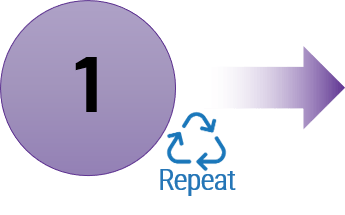
|
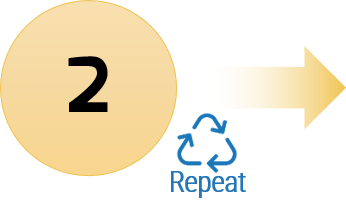
|

|
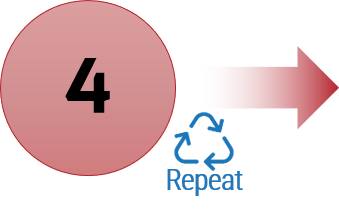
|
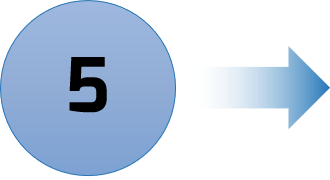
|
|
Align and prepare your IT leadership teams. Audience: Senior and IT delivery leadership Size: 8-16 people Time: 7 hours |
Tune Agile team practices to fit your organization culture. Audience: Agile pilot teams and subject matter experts (SMEs) Size: 10-20 people Time: 4 days |
Leverage Agile thought leadership to expand your best practices. Audience: Agile SMEs and thought leaders Size: 10-20 people Time: 4 days |
Build a continuous integration and continuous delivery pipeline. Audience: Product owners (POs) and delivery team leads Size: 10-20 people Time: 4 days |
Execute a disciplined approach to rolling out Agile methods. Audience: Agile steering team and SMEs Size: 3-8 people Time: 3 hours |

Sample agendas are included in the following sections for each of these topics.
Your Product Transformation Journey
| 1. Make the Case for Product Delivery | 2. Enable Product Delivery - Executive Workshop | 3. Deliver on Your Digital Product Vision | 4. Deliver Digital Products at Scale | 5. Mature and Scale Product Ownership |
|---|---|---|---|---|
| Align your organization with the practices to deliver what matters most. | Participate in a one-day executive workshop to help you align and prepare your leadership. | Enhance product backlogs, roadmapping, and strategic alignment. | Scale product families to align with your organization's goals. | Align and mature your product owners. |
Audience: Senior executives and IT leadership Size: 8-16 people Time: 6 hours
| Audience: Product owners/managers Size: 10-20 people Time: 3-4 days
| Audience: Product owners/managers Size: 10-20 people Time: 3-4 days | Audience: Product owners/managers Size: 8-16 people Time: 2-4 days
|

Phase 1
Determine if SAFe Is Right for Your Organization
Phase 1
1.1 Understand where SAFe fits into your delivery methodologies and SDLCs
1.2 Determine if you are ready for SAFe (fit for purpose)
This phase will walk you through the following activities:
- 1.1.1 Define your primary drivers for SAFe.
- 1.1.2 Create your own list of pros and cons of SAFe.
- 1.2.1 Assess your Agile readiness.
- 1.2.2 Define enablers and blockers for scaling Agile delivery.
- 1.2.3 Estimate your SAFe implementation risk.
- 1.2.4 Start your SAFe implementation plan.
This phase involves the following participants:
- Senior leadership
- IT leadership
- Project Management Office
- Delivery managers
- Product managers/owners
- Agile thought leaders and coaches
- Compliance teams leads
Step 1.1
Understand where SAFe fits into your delivery methodologies and SDLCs
Activities
1.1.1 Define your primary drivers for SAFe
1.1.2 Create your own list of pros and cons of SAFe
This step involves the following participants:
- IT leadership
- Delivery managers
- Project management office
- Product owners and managers
- Development team leads
- Portfolio managers
- Architects
Outcomes of this step:
- List of primary drivers for SAFe
- List of pros and cons of SAFe
Agile's Four Core Values
"...while there is value in the items on the right, we value the items on the left more."
– The Agile Manifesto
STOP! If you're not Agile, don't start with SAFe.
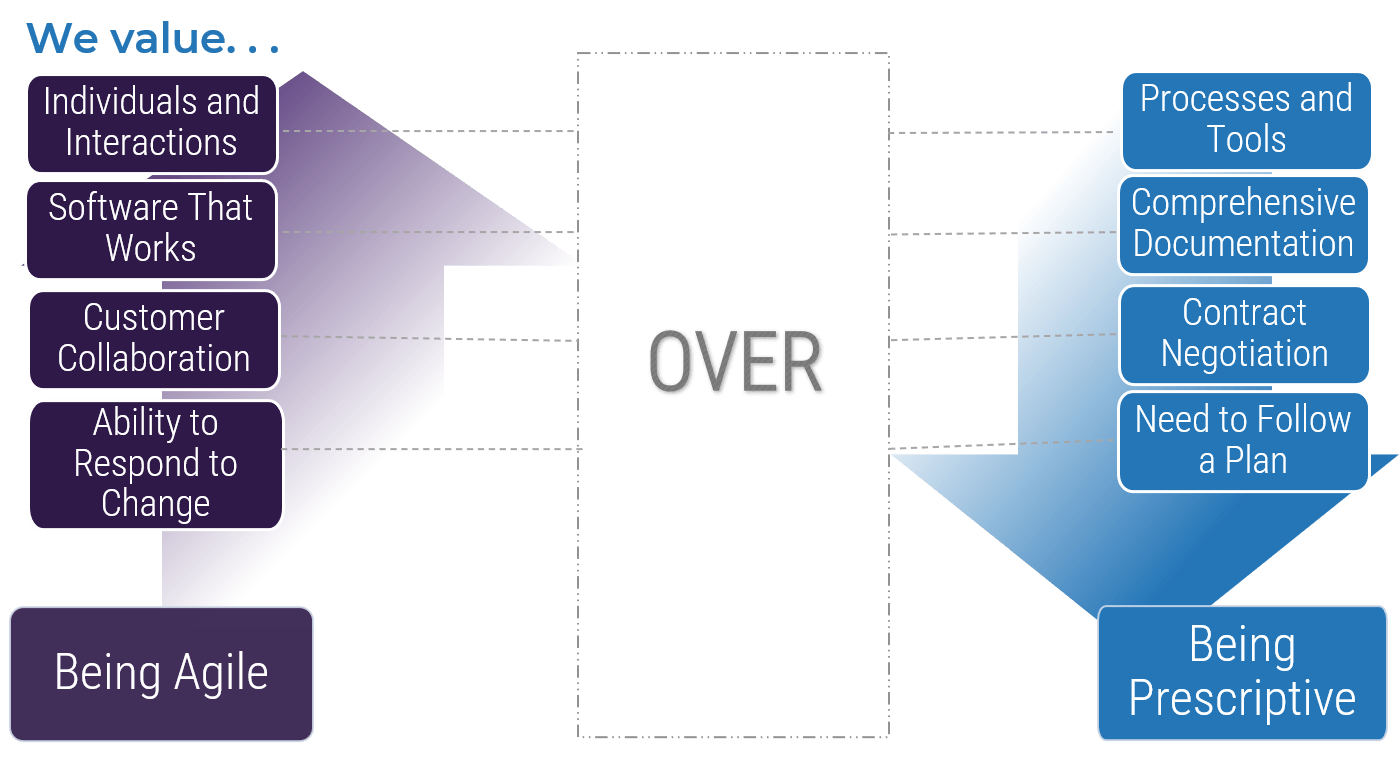
Successful SAFe requires an Agile mindset at all levels.
Be aware of common myths around Agile and SAFe
SAFe does not...
1...solve development and communication issues.
2...ensure that you will finish requirements faster.
3...mean that you do not need planning and documentation.
"Without proper planning, organizations can start throwing more resources at the work, which spirals into the classic Waterfall issues of managing by schedule."
– Kristen Morton, Associate Implementation Architect,
OneShield Inc. (Info-Tech Interview)
Info-Tech Insight
SAFe only provides a framework and steps where these issues can be resolved.
The importance of values and principles
Modern development practices (such as Agile, Lean, and DevOps) are based on values and principles. This supports the move away from command-and-control management to self-organizing teams.
Values
- Values represent your team's core beliefs and capture what you want to instill in your team.
Principles
- Principles represent methods for solving a problem or deciding.
- Given that principles are rooted in specifics, they can change more frequently because they are both fallible and conducive to learning.
Consider the guiding principles of your application team
Teams may have their own perspectives on how they deliver value and their own practices for how they do this. These perspectives can help you develop guiding principles for your own team to explain your core values and cement your team's culture. Guiding principles can help you:
- Enable the appropriate environment to foster collaboration within current organizational, departmental, and cultural constraints
- Foster the social needs that will engage and motivate your team in a culture that suits its members
- Ensure that all teams are driven toward the same business and team goals, even if other teams are operating differently
- Build organizational camaraderie aligned with corporate strategies
Info-Tech Insight
Following methodologies by the book can be detrimental if they do not fit your organization's needs, constraints, and culture. The ultimate goal of all teams is to deliver value. Any practices or activities that drive teams away from this goal should be removed or modified.
Review the drivers that are motivating your organization to adopt and scale Agile practices
Functional groups have their own drivers to adopt Agile development processes, practices, and techniques (e.g. to improve collaboration, decrease churn, or increase automation). Their buy-in to scaling Agile is just as important as the buy-in of stakeholders.
By not addressing a group's specific needs and drivers, the resulting negative sentiments of its members toward Agile development can affect their ability to see the benefits of Agile and they may return to old habits once the opportunity arises.
Find opportunities in which both business objectives and functional group drivers can be achieved with scaling Agile development. This alignment can motivate teams to continuously improve and adhere to the new environment, and it will maintain business buy-in. This assessment can also be used to justify activities that specifically address functional group drivers.
Examples of Motivating Drivers for Scaling Agile
- Improve artifact hand-offs between development and operations.
- Increase collaboration among development teams.
- Reveal architectural and system risks early.
- Expedite the feedback loop from support.
- Improve capacity management.
- Support development process innovation.
- Create a safe environment to discuss concerns.
- Optimize value streams.
- Increase team engagement and comradery.
Exercise 1.1.1 Define your primary drivers for SAFe
30 minutes
- Brainstorm a list of drivers for scaling Agile.
- Build a value canvas to help capture and align team expectations.
- Identify jobs or functions that will be impacted by SAFe.
- List your current pains and gains.
- List the pain relievers and gain creators.
- Identify the deliverable needed for a successful transformation.
- Complete your SAFe value canvas in your SAFe Transformation Playbook.
Enter the results in your SAFe Transformation Playbook.
| Input |
|---|
|
| Output |
|
SAFe Value Canvas Template
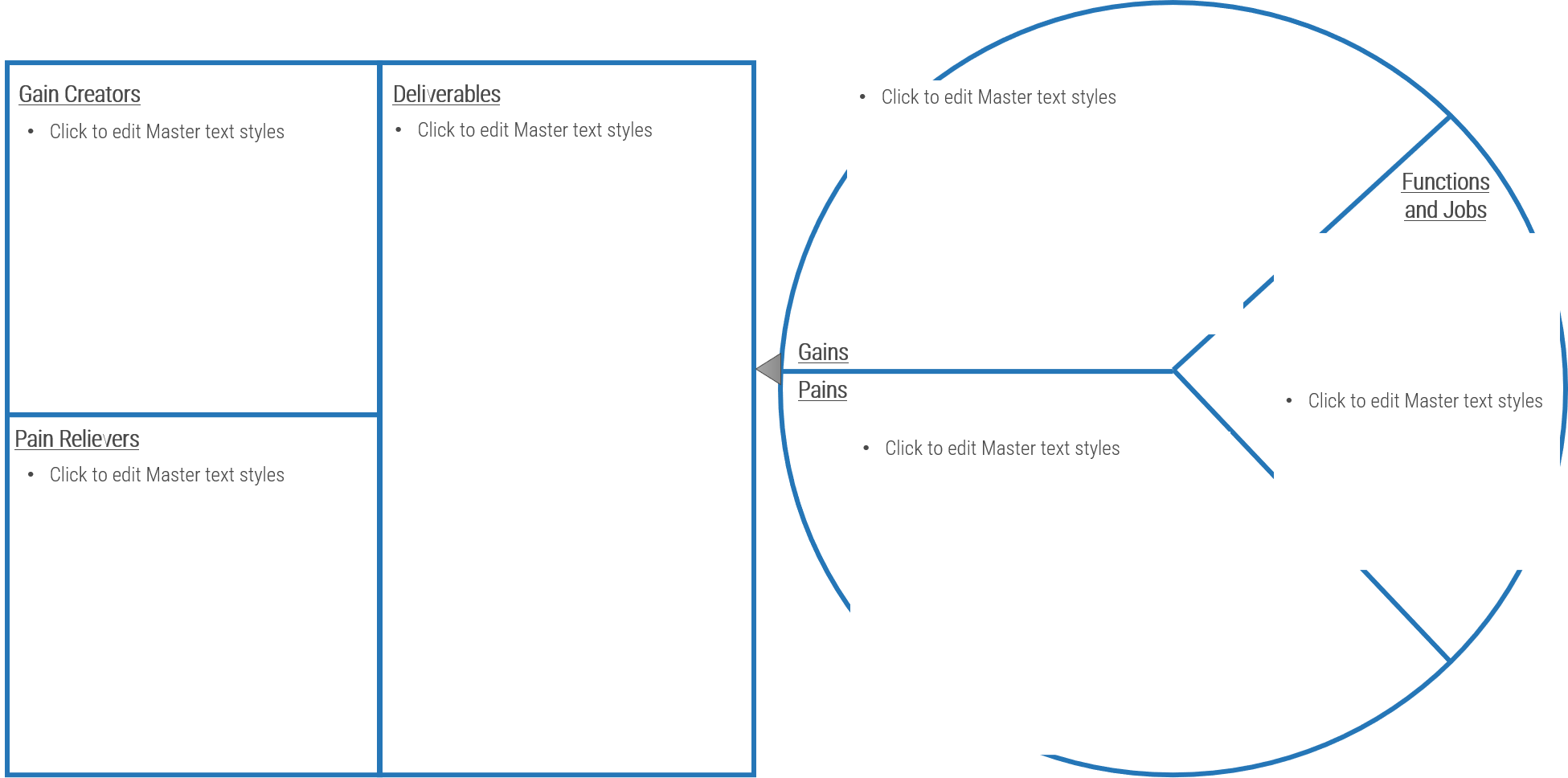
Case Study
A public utilities organization steadily lost stakeholder engagement, diminishing product quality.
INDUSTRY: Public Utilities
SOURCE: Info-Tech Expert Interview
Challenge
- The goal of a public utilities organization was to adopt Agile so it could quickly respond to changes and trim costs.
- The organization decided to scale Agile using a structured approach. It began implementation with IT teams that were familiar with Agile principles and leveraged IT seniors as Agile champions. To ensure that Agile principles were widespread, the organization decided to develop a training program with vendor assistance.
- As Agile successes began to be seen, the organization decided to increase the involvement of business teams gradually so it could organically grow the concept within the business.
Results
- Teams saw significant success with many projects because they could easily demonstrate deliverables and clearly show the business value. Over time, the teams used Agile for large projects with complex processing needs.
- Teams continued to deliver small projects successfully, but business engagement waned over time. Some of the large, complex applications they delivered using Agile lacked the necessary functionality and appropriate controls and, in some cases, did not have the ability to scale due to a poor architectural framework. These applications required additional investment, which far exceeded the original cost forecasts.
While Agile and product development are intertwined, they are not the same!
Delivering products does not necessarily require an Agile mindset. However, Agile methods help to facilitate the journey because product thinking is baked into them.
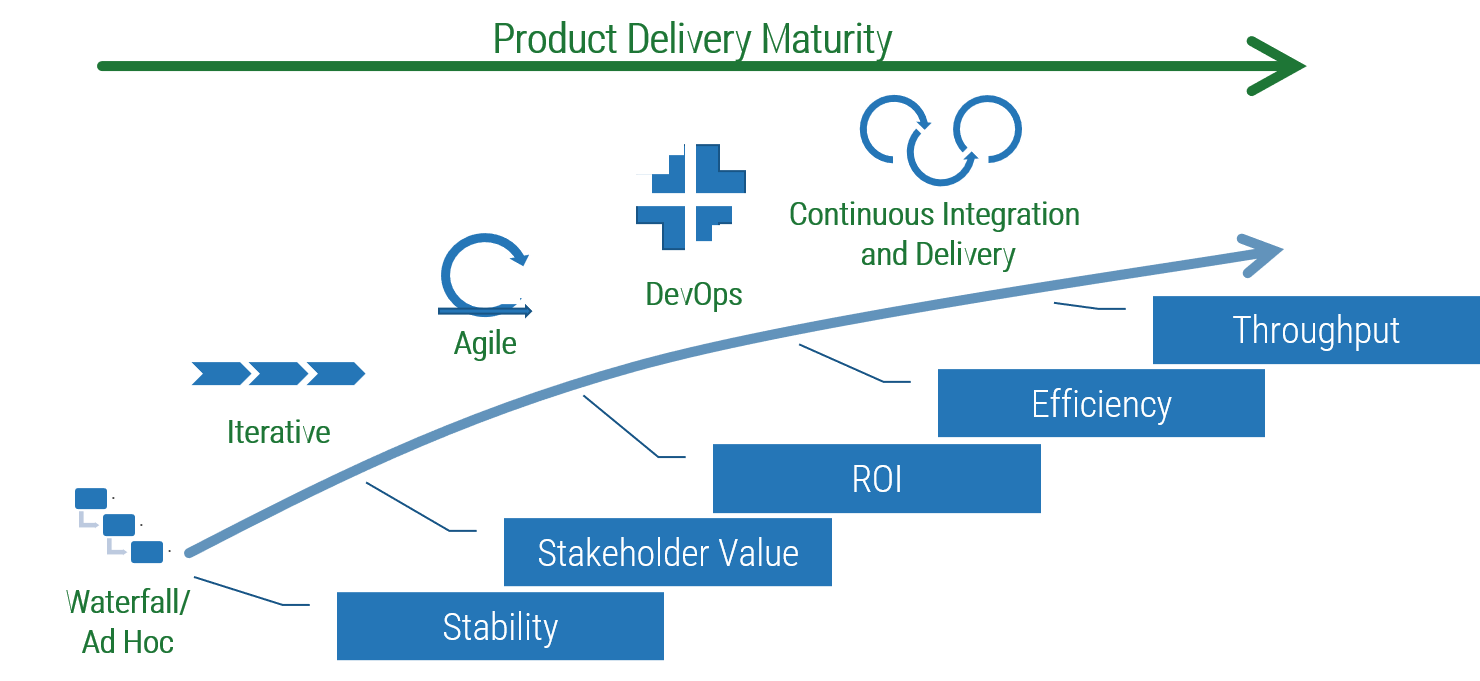
Recognize the difference between Scrum teams and the Scaled Agile Framework (SAFe)
SAFe provides a framework that aligns Scrum teams into coordinated release trains driven by top-down prioritization.
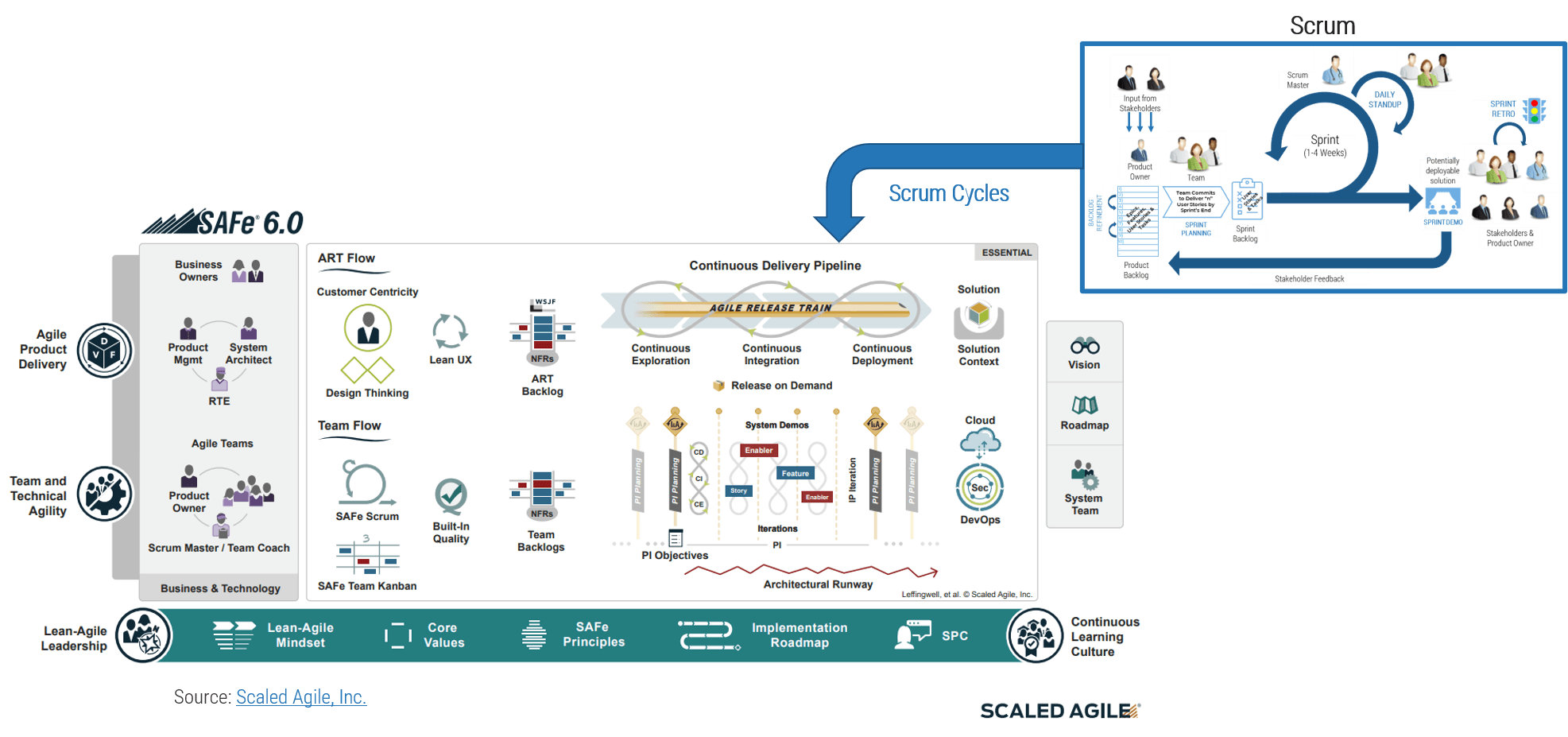
Without adopting an Agile mindset, SAFe becomes Waterfall with SAFe terminology
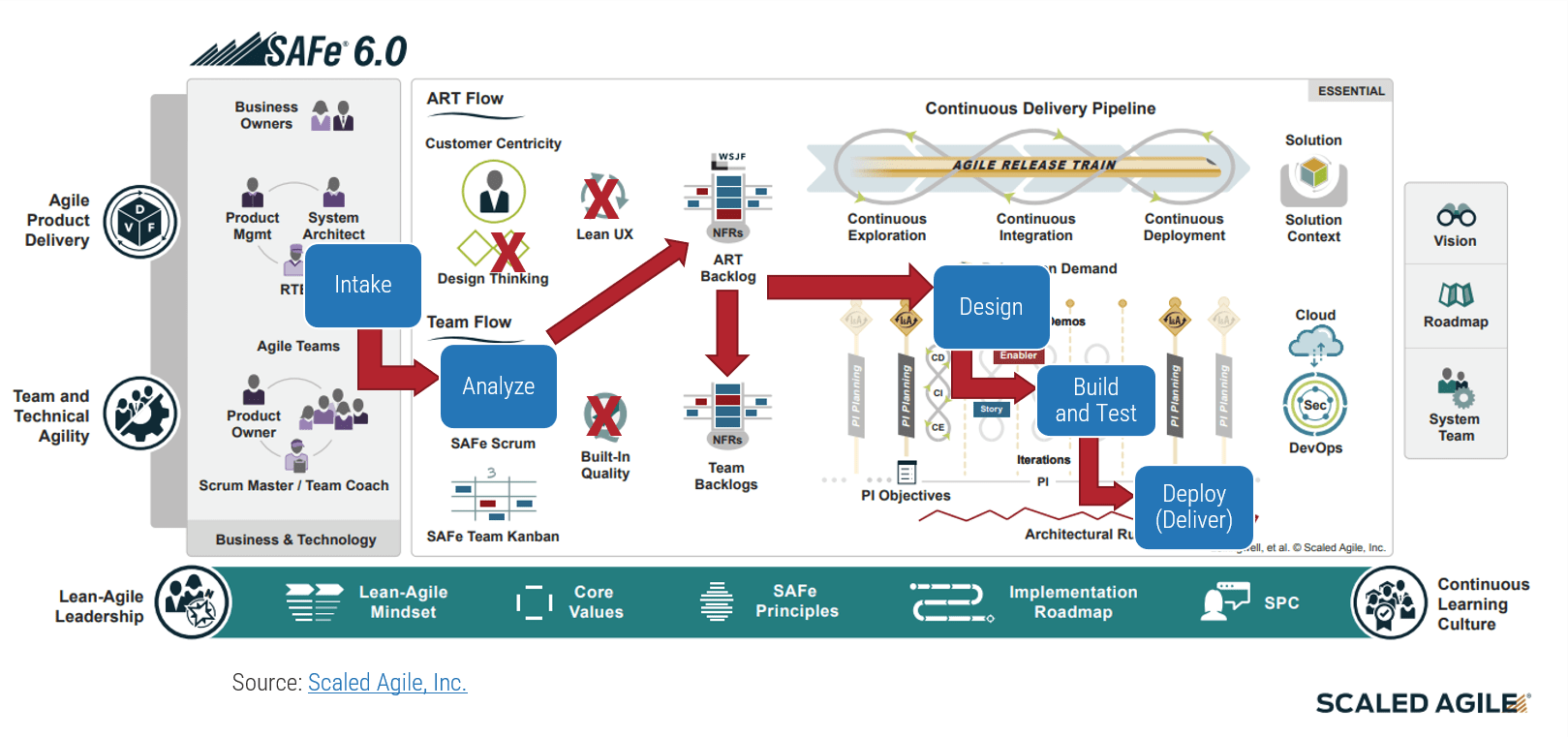
Info-Tech Insight
When first implementing SAFe, organizations reproduce their organizational design and Waterfall delivery structures with SAFe terms:
- Delivery Manager = Release Train Engineer
- Stakeholder/Sponsor = Product Manager
- Release = Release Train
- Project/Program = Project or Portfolio
Advantages of successful SAFe implementations
Once SAFe is complete and operational, organizations have seen measurable benefits:
- Multiple frameworks to support different levels of SAFe usage
- Deliberate and consistent planning and coordination
- Coordinating dependencies within value streams
- Reduced time to delivery
- Focus on customers and end users
- Alignment to business goals and value streams
- Increased employee engagement
Sources: TechBeacon, 2019; Medium, 2020; "Benefits," Scaled Agile, 2023;
"Pros and Cons," PremierAgile, n.d.; "Scaling Agile Challenges," PremierAgile, n.d.
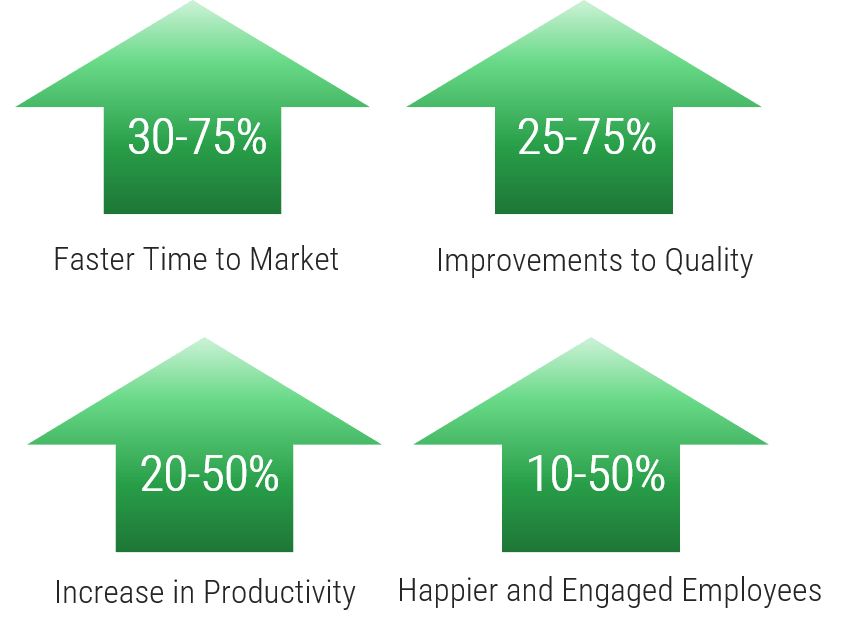
Source: "Benefits," Scaled Agile, 2023
SAFe isn't without risks or challenges
Risks and Causes of Failed SAFe Transformations
- SAFe conflicts with legacy cultures and delivery processes.
- SAFe promotes continued top-down decisions, undermining team empowerment.
- Scaled product families are required to define proper value streams.
- Team empowerment and autonomy are reduced.
- SAFe activities are poorly executed.
- There are high training and coaching costs.
- Implementation takes a long time.
- End-to-end delivery management tools aligned to SAFe are required.
- Legacy delivery challenges are not specifically solved with SAFe.
- SAFe is designed to work for large-scale development teams.
Challenges
- Adjusting to a new set of terms for common roles, processes, and activities
- Executing planning cycles
- Defining features and epics at the right level
- Completing adequate requirements
- Defining value streams
- Coordinating releases and release trains
- Providing consistent quality
Sources: TechBeacon, 2019; Medium, 2020; "Benefits," Scaled Agile, 2023; "Pros and Cons," PremierAgile, n.d.; "Scaling Agile Challenges," PremierAgile, n.d.
Exercise 1.1.2 Create your own list of the pros and cons of SAFe
1 hour
| Pros | Cons |
Enter the results in your SAFe Transformation Playbook
| Input |
|---|
|
| Output |
|
Focus on your core competencies instead
Before undertaking an enterprise transformation, consider improving the underlying processes that will need to be fixed anyway. Fixing these areas while implementing SAFe compounds the effort and disruption.
Product Delivery
- Agile/DevOps Research Center
- Develop Your Agile Approach for a Successful Transformation
- Understand Agile fundamentals, principles, and practices so you can apply them effectively in your organization.
- Implement DevOps Practices That Work
- Streamline business value delivery through the strategic adoption of DevOps practices.
Product Management
- Product Lifecycle Management Research Center
- Make the Case for Product Delivery
- Align your organization on the practices to deliver what matters most.
- Deliver on Your Digital Product Vision
- Build a product vision your organization can take from strategy through execution.
- Deliver Digital Products at Scale
- Deliver value at the scale of your organization through defining enterprise product families.
- Introduce Program Management to Your Organization
- Use programs to align projects to your strategic goals.
- Optimize IT Project Intake, Approval, and Prioritization
- Decide which IT projects to approve and when to start them.
- Managing Requirements in an Agile Environment
- Agile and requirements management are complementary, not competitors.
- Build a Software Quality Assurance Program
- Build quality into every step of your SDLC.
- Automate Testing to Get More Done
- Drive software delivery throughput and quality confidence by extending your automation test coverage.
- Application Portfolio Management Foundations
- Ensure your application portfolio delivers the best possible return on investment.
"But big-bang transitions are hard. They require total leadership commitment, a receptive culture, enough talented and experienced agile practitioners to staff hundreds of teams without depleting other capabilities, and highly prescriptive instruction manuals to align everyone's approach."
- "Agile at Scale," Harvard Business Review
Step 1.2
Determine if you are ready for SAFe (fit for purpose)
Activities
1.2.1 Assess your Agile readiness
1.2.2 Define enablers and blockers for scaling Agile delivery
1.2.3 Estimate your SAFe implementation risk
1.2.4 Start your SAFe implementation plan
This step involves the following participants:
- IT leadership
- Delivery managers
- Project management office
- Product owners and managers
- Development team leads
- Portfolio managers
- Architects
Outcomes of this step:
- Agile Readiness Assessment results
- Enablers and blockers for scaling Agile
- SAFe implementation risk
- SAFe implementation plan
Use CLAIM to guide your Agile journey
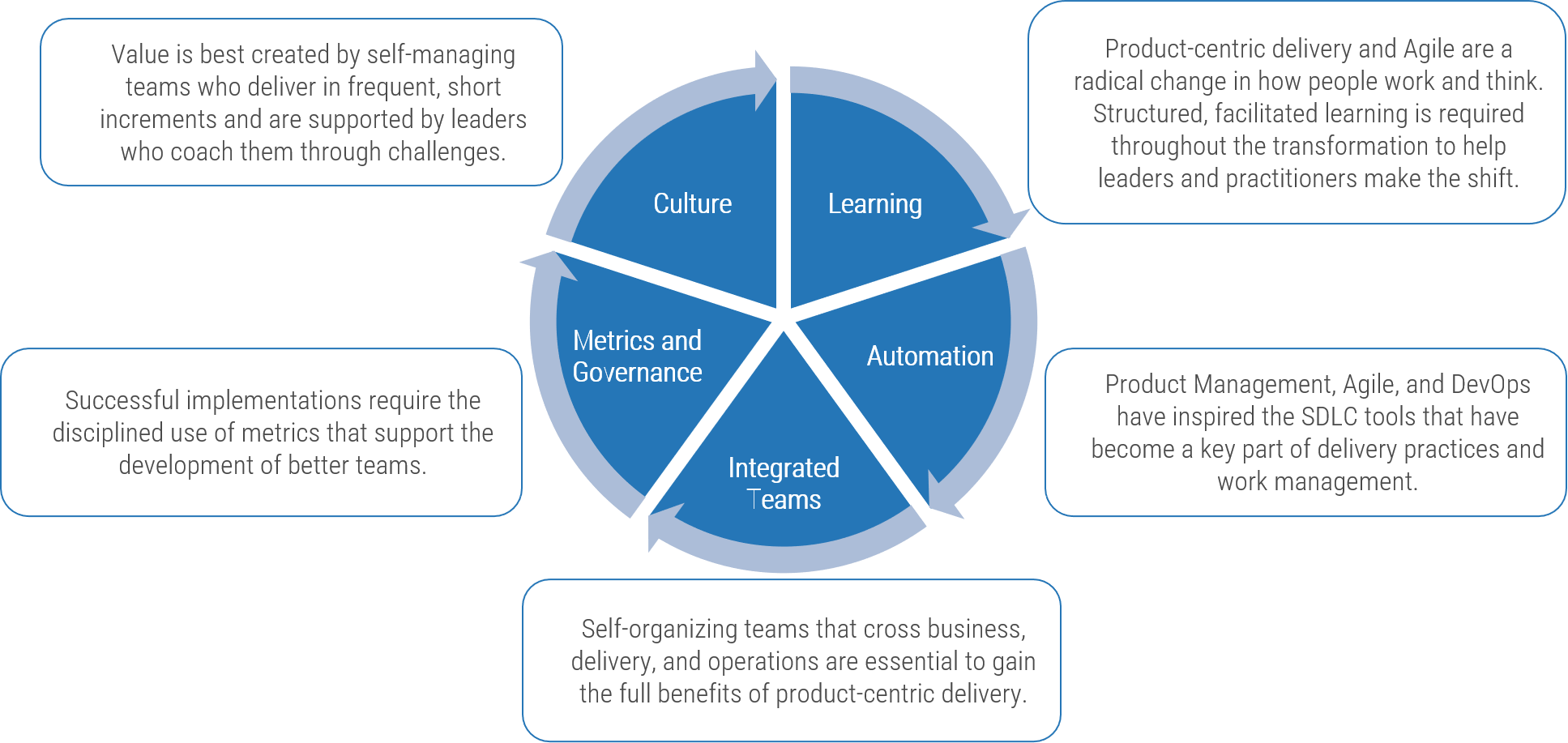
Conduct the Agile Readiness Assessment Survey
Without an Agile mindset, SAFe will follow Waterfall or WaterScrumFall practices.
- Start your journey with a clear understanding of the level of Agile and product maturity throughout your organization.
- Each area that lacks strength should be evaluated further and added to your journey map.
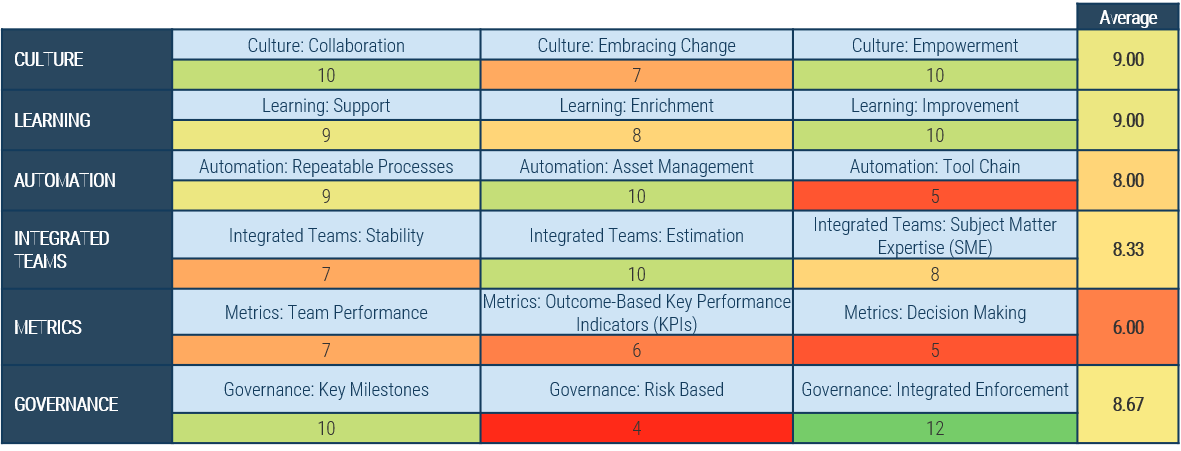
Exercise 1.2.1 Assess your Agile readiness
1 hour
- Open and complete the Agile Readiness Assessment in your playbook or the Excel tool provided.
- Discuss each area's high and low scores to reach a consensus.
- Record your results in your SAFe Transformation Playbook.
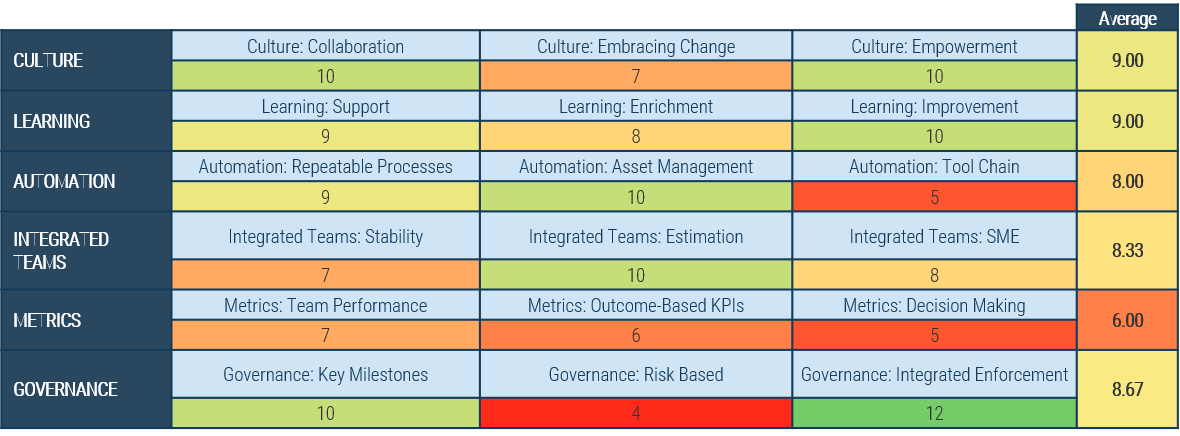
Enter the results in Scaled Agile Readiness Assessment.
| Input |
|---|
|
| Output |
|
Exercise 1.2.2 Define enablers and blockers for scaling Agile delivery
1 hour
- Identify and mitigate blockers for scaling Agile in your organization.
- Identify enablers who will support successful SAFe transformation.
- Identify blockers who will make the transition to SAFe more difficult.
- For each blocker, define at least one mitigating step.
| Enablers | Blockers | Mitigation |
Enter the results in your SAFe Transformation Playbook
| Input |
|---|
|
| Output |
|
Estimate your SAFe implementation risk
| Poor Fit | High Risk | Scaling Potential | |
| Team size | <50 | >150 or non-dedicated | 50-150 dedicated |
| Agile maturity | Waterfall and project delivery | Individual Scrum DevOps teams | Scrum DevOps teams coordinating dependencies |
| Product management maturity | Project-driver changes from stakeholders | Proxy product owners within delivery teams | Defined product families and products |
| Strategic goals | Localized decisions | Enterprise goals implemented at the app level | Translation and refinement of enterprise goals through product families |
| Enterprise architecture | Siloed architecture standards | Common architectures | Future enterprise architecture and employee review board (ERB) reviews |
| Release management | Independent release schedules | Formal release calendar | Continuous integration/development (CI/CD) with organizational change management (OCM) scheduled cross-functional releases |
| Requirements management and quality assurance | Project based | Partial requirements and test case coverage | Requirements as an asset and test automation |
Exercise 1.2.3 Estimate your SAFe implementation risk
30 minutes
- Determine which description best matches your overall organizational state.
- Enter the results in your SAFe Transformation Playbook.
- Change the text to bold in the cell you selected to describe your current state and/or add a border around the cell.
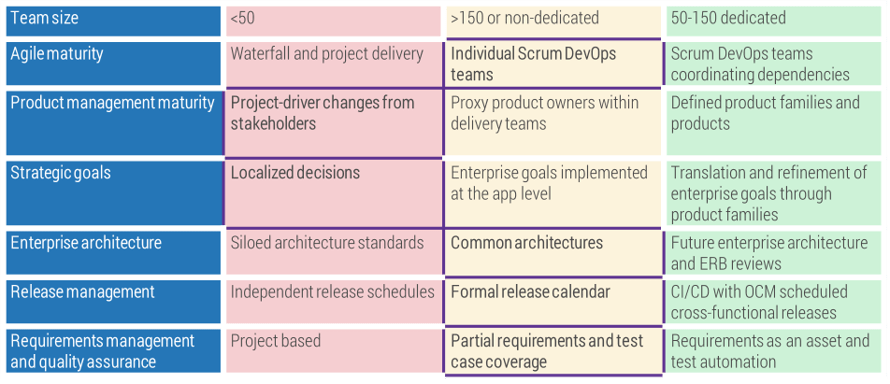
Enter the results in SAFe Transformation Playbook.
| Input |
|---|
|
| Output |
|
Interpret your SAFe implementation risks
Analyze your highlighted selections and patterns in the rows and columns. Use these factors to inform your SAFe implementation steps and timing.
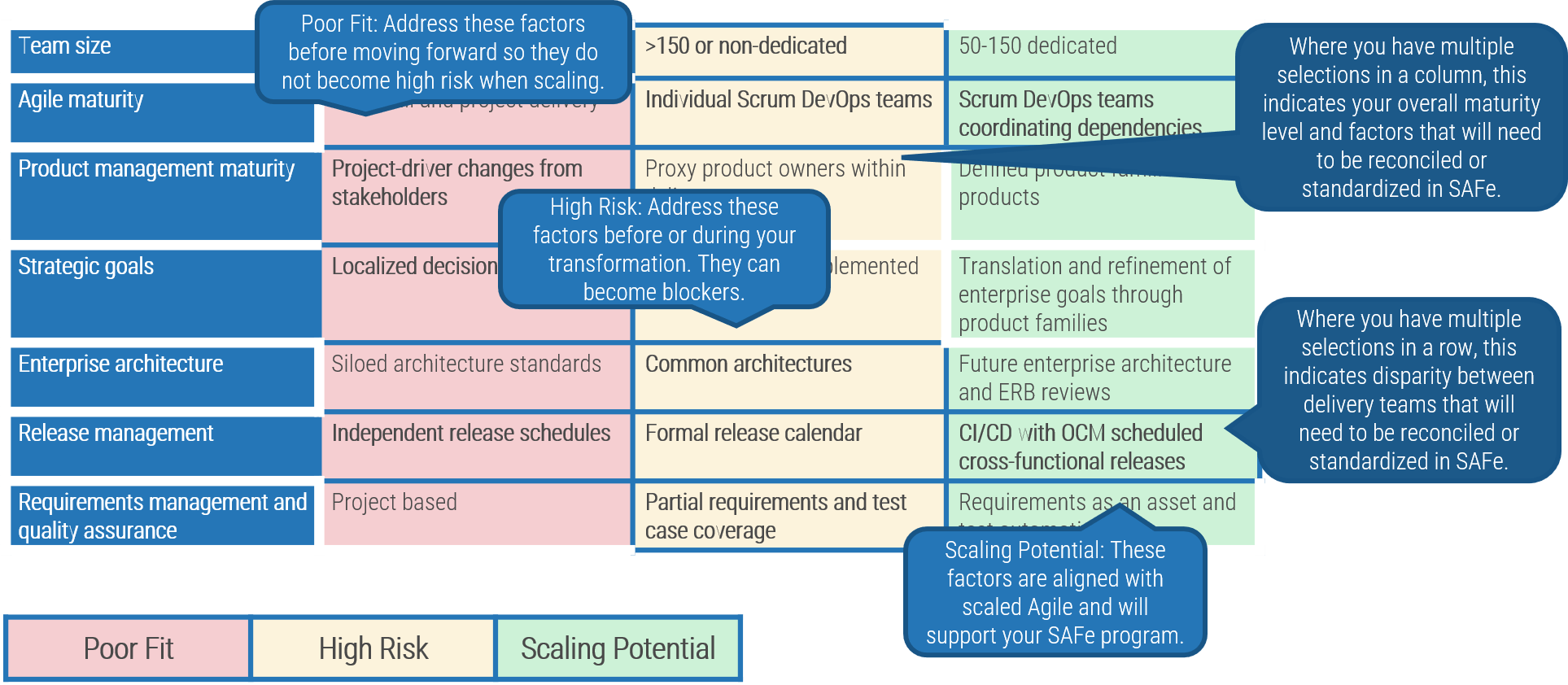
Build your implementation plan
Build a transformation and organizational change management plan to guide your transition. Define clear ownership for every critical step.
Plan your transformation.
- Align stakeholders and thought leaders.
- Select an implementation partner.
- Insert critical steps.
Build your SAFe framework.
- Define your target SAFe framework.
- Customize your SAFe framework.
- Establish SAFe governance and reporting.
- Insert critical steps.
Implement SAFe practices.
- Define product families and value streams.
- Conduct SAFe training for:
- Executive leadership
- Agile SAFe coaches
- Practitioners
- Insert critical steps.
For additional help with OCM, please download Master Organizational Change Management Practices.
Exercise 1.2.4 Start your SAFe implementation plan
30 minutes
- Using the high-level SAFE implementation framework, begin building out the critical steps.
- Record the results in your SAFe Transformation Playbook.
- Your playbook is an evergreen document to help guide your implementation. It should be reviewed often.
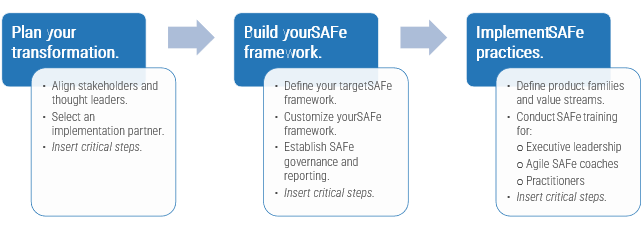
Enter the results in your SAFe Transformation Playbook
| Input |
|---|
|
| Output |
|
Select an implementation partner
Finding the right SAFe implementation partner is critical to your transformation success.
- Using your previous assessment, align internal and external resources to support your transformation.
- Select a partner who has experience in similar organizations and is aligned with your delivery goals.
- Plan to transition support to internal teams when SAFe practices have stabilized and moved into continuous improvement.
- Augment your transformation partner with internal coaches.
- Plan for a multiyear engagement before SAFe benefits are realized.
Summary of Accomplishments
Your journey begins.
Implementing SAFe is a long, expensive, and difficult process. For some organizations, SAFe provides the balance of leadership-driven prioritization and control with shorter release cycles and time to value. The key is making sure that SAFe is right for you and you are ready for SAFe. Few organizations fit perfectly into one of the SAFe frameworks. Instead, consider fine-tuning and customizing SAFe to meet your needs and gradual transformation.
If you would like additional support, have our analysts guide you through other phases as part of an Info-Tech workshop.
Contact your account representative for more information.
workshops@infotech.com
1-888-670-8889
Additional Support
If you would like additional support, have our analysts guide you through other phases as part of an Info-Tech Workshop.
To accelerate this project, engage your IT team in an Info-Tech workshop with an Info-Tech analyst team.
Info-Tech analysts will join you and your team at your location or welcome you to Info-Tech's historic Toronto office to participate in an innovative onsite workshop.
Below are sample activities that will be conducted by Info-Tech analysts with your team:
Scaled Agile Delivery Readiness Assessment
This assessment will help identify enablers and blockers in your organizational culture using our CLAIM+G organization transformation model.
SAFE Value Canvas
Use a value campus to define jobs, pains, gains, pain relievers, gain creators, and needed deliverables to help inform and guide your SAFe transformation.
Contact your account representative for more information.
workshops@infotech.com 1-888-670-8889
Bibliography
"6 Biggest SAFe Agile Implementation Mistakes to Avoid." Triumph Strategic Consulting, 27 July 2017.
"The 7 Must-Haves for Achieving Scaling Agile Success." The 7 Must-Haves for Achieving Scaling Agile Success.
Ageling, Willem-Jan. "11 Most Common Reasons to Use Scaled Agile Framework (SAFE) and How to Do This With Unscaled Scrum." Medium, Serious Scrum, 26 Jan. 2020.
Agile India, International Conference on Agile and Lean Software Development, 2014.
"Air France - KLM - Agile Adoption with SAFe." Scaled Agile, 28 Nov. 2022.
"Application Development Trends 2019 - Global Survey Report." OutSystems.
"Benefits of SAFe: How It Benefits Organizations." Scaled Agile, 13 Mar. 2023.
Berkowitz, Emma. "The Cost of a SAFe(r) Implementation: CPRIME Blog." Cprime, 30 Jan. 2023.
"Chevron - Adopting SAFe with Remote Workforce." Scaled Agile, 28 Nov. 2022.
"Cisco It - Adopting Agile Development with SAFe." Scaled Agile, 13 Sept. 2022.
"CMS - Business Agility Transformation Using SAFe." Scaled Agile, 13 Sept. 2022.
Crain, Anthony. "4 Biggest Challenges in Moving to Scaled Agile Framework (SAFe)." TechBeacon, 25 Jan. 2019.
"The Essential Role of Communications ." Project Management Institute .
Gardiner, Phil. "SAFe Implementation: 4 Tips for Getting Started." Applied Frameworks, 20 Jan. 2022.
"How Do I Start Implementing SAFe?" Agility in Mind, 29 July 2022.
"How to Masterfully Screw Up Your SAFe Implementation." Wibas Artikel-Bibliothek, 6 Sept. 2022.
"Implementation Roadmap." Scaled Agile Framework, 14 Mar. 2023.
Islam, Ayvi. "SAFe Implementation 101 - The Complete Guide for Your Company." //Seibert/Media, 22 Dec. 2020.
"Johnson Controls - SAFe Implementation Case Study." Scaled Agile, 28 Nov. 2022.
"The New Rules and Opportunities of Business Transformation." KPMG.
"Nokia Software - SAFe Agile Transformation." Scaled Agile, 28 Nov. 2022.
Pichler, Roman. "What Is Product Management?" Romanpichler, 2014.
"Product Documentation." ServiceNow.
"Pros and Cons of Scaled Agile Framework." PremierAgile.
"Pulse of the Profession Beyond Agility." Project Management Institute.
R, Ramki. "Pros and Cons of Scaled Agile Framework (SAFe)." Medium, 3 Mar. 2019.
R, Ramki. "When Should You Consider Implementing SAFe (Scaled Agile Framework)?" Medium, Medium, 3 Mar. 2019.
Rigby, Darrell, Jeff Sutherland, and Andy Noble. "Agile at Scale: How to go from a few teams to hundreds." Harvard Business Review, 2018.
"SAFe Implementation Roadmap." Scaled Agile Framework, Scaled Agile, Inc., 14 Mar. 2023.
"SAFe Partner Cprime: SAFe Implementation Roadmap: Scaled Agile." Cprime, 5 Apr. 2023.
"SAFe: The Good, the Bad, and the Ugly." Project Management Institute.
"Scaled Agile Framework." Wikipedia, Wikimedia Foundation, 29 Mar. 2023.
"Scaling Agile Challenges and How to Overcome Them." PremierAgile.
"SproutLoud - a Case Study of SAFe Agile Planning." Scaled Agile, 29 Nov. 2022.
"Story." Scaled Agile Framework, 13 Apr. 2023.
Sutherland , Jeff. "Scrum: How to Do Twice as Much in Half the Time." Tedxaix, YouTube, 7 July 2014.
Venema, Marjan. "6 Scaled Agile Frameworks - Which One Is Right for You?" NimbleWork, 23 Dec. 2022.
Warner, Rick. "Scaled Agile: What It Is and Why You Need It." High-Performance Low-Code for App Development, OutSystems, 25 Oct. 2019.
Watts, Stephen, and Kirstie Magowan. "The Scaled Agile Framework (SAFE): What to Know and How to Start." BMC Blogs, 9 Sept. 2020.
"What Is SAFe? The Scaled Agile Framework Explained." CIO, 9 Feb. 2021.
"Why Agile Transformations Fail: Four Common Culprits." Planview.
"Why You Should Use SAFe (and How to Find SAFe Training to Help)." Easy Agile.
Y., H. "Story Points vs. 'Ideal Days.'" Cargo Cultism, 19 Aug. 2010.
Bibliography
Enable Organization-Wide Collaboration by Scaling Agile
Ambler, Scott W. "Agile Architecture: Strategies for Scaling Agile Development." Agile Modeling, 2012.
- - -. "Comparing Approaches to Budgeting and Estimating Software Development Projects." AmbySoft.
- - -. "Agile and Large Teams." Dr. Dobb's, 17 Jun 2008.
Ambler, Scott W. and Mark Lines. Disciplined Agile Delivery: A Practitioner's Guide to Agile Software Delivery in the Enterprise. IBM Press, 2012.
Ambler, Scott W., and Mark Lines. "Scaling Agile Software Development: Disciplined Agility at Scale." Disciplined Agile Consortium White Paper Series, 2014.
AmbySoft. "2014 Agile Adoption Survey Results." Scott W. Ambler + Associates, 2014.
Bersin, Josh. "Time to Scrap Performance Appraisals?" Forbes Magazine, 5 June 2013. Accessed 30 Oct. 2013..
Cheese, Peter, et al. " Creating an Agile Organization." Accenture, Oct. 2009. Accessed Nov. 2013..
Croxon, Bruce, et al. "Dinner Series: Performance Management with Bruce Croxon from CBC's 'Dragon's Den.'" HRPA Toronto Chapter. Sheraton Hotel, Toronto, ON, 12 Nov. 2013. Panel discussion.
Culbert, Samuel. "10 Reasons to Get Rid of Performance Reviews." Huffington Post Business, 18 Dec. 2012. Accessed 28 Oct. 2013.
Denning, Steve. "The Case Against Agile: Ten Perennial Management Objections." Forbes Magazine, 17 Apr. 2012. Accessed Nov. 2013.
Estis, Ryan. "Blowing up the Performance Review: Interview with Adobe's Donna Morris." Ryan Estis & Associates, 17 June 2013. Accessed Oct. 2013.
Heikkila et al. "A Revelatory Case Study on Scaling Agile Release Planning." EUROMICRO Conference on Software Engineering and Advanced Applications (SEAA), 2010.
Holler, Robert, and Ian Culling. "From Agile Pilot Project to Enterprise-Wide Deployment: Five Sure-Fire Ways To Fail When You Scale." VersionOne, 2010.
Kniberg, Henrik, and Anders Ivarsson, "Scaling Agile @ Spotify," Unified Communications and Collaborations, 2012.
Narayan, Sriram. "Agile IT Organization Design: For Digital Transformation and Continuous Delivery." Addison-Wesley Professional, 2015.
Shrivastava, NK, and Phillip George. "Scaling Agile." RefineM, 2015.
Sirkia, Rami, and Maarit Laanti. "Lean and Agile Financial Planning." Scaled Agile Framework Blog, 2014.
Scaled Agile Framework (SAFe). "Agile Architecture." Scaled Agile Inc., 2015.
VersionOne. 9th Annual: State of Agile Survey. VersionOne, LLC, 2015.
Appendix A: Supporting Info-Tech Research
Transformation topics and supporting research to make your journey easier, with less rework
Supporting research and services
Improving IT Alignment
Build a Business-Aligned IT Strategy
Success depends on IT initiatives clearly aligned to business goals, IT excellence, and driving technology innovation.
Make Your IT Governance Adaptable
Governance isn't optional, so keep it simple and make it flexible.
Create an IT View of the Service Catalog
Unlock the full value of your service catalog with technical components.
Application Portfolio Management Foundations
Ensure your application portfolio delivers the best possible return on investment.
Shifting Toward Agile DevOps
Agile/DevOps Research Center
Access the tools and advice you need to be successful with Agile.
Develop Your Agile Approach for a Successful Transformation
Understand Agile fundamentals, principles, and practices so you can apply them effectively in your organization.
Implement DevOps Practices That Work
Streamline business value delivery through the strategic adoption of DevOps practices.
Perform an Agile Skills Assessment
Being Agile isn't about processes, it's about people.
Define the Role of Project Management in Agile and Product-Centric Delivery
Projects and products are not mutually exclusive.
Shifting Toward Product Management
Make the Case for Product Delivery
Align your organization on the practices to deliver what matters most.
Deliver on Your Digital Product Vision
Build a product vision your organization can take from strategy through execution.
Deliver Digital Products at Scale
Deliver value at the scale of your organization through defining enterprise product families.
Mature and Scale Product Ownership
Strengthen the product owner role in your organization by focusing on core capabilities and proper alignment.
Build a Value Measurement Framework
Focus product delivery on business value- driven outcomes.
Improving Value and Delivery Metrics
Build a Value Measurement Framework
Focus product delivery on business value-driven outcomes.
Create a Holistic IT Dashboard
Mature your IT department by measuring what matters.
Select and Use SDLC Metrics Effectively
Be careful what you ask for, because you will probably get it.
Reduce Time to Consensus With an Accelerated Business Case
Expand on the financial model to give your initiative momentum.
Improving Governance, Prioritization, and Value
Make Your IT Governance Adaptable
Governance isn't optional, so keep it simple and make it flexible.
Maximize Business Value From IT Through Benefits Realization
Embed benefits realization into your governance process to prioritize IT spending and confirm the value of IT.
Drive Digital Transformation With Platform Strategies
Innovate and transform your business models with digital platforms.
Succeed With Digital Strategy Execution
Building a digital strategy is only half the battle: create a systematic roadmap of technology initiatives to execute the strategy and drive digital transformation.
Build a Value Measurement Framework
Focus product delivery on business value-driven outcomes.
Create a Holistic IT Dashboard
Mature your IT department by measuring what matters.
Improving Requirements Management and Quality Assurance
Requirements Gathering for Small Enterprises
Right-size the guidelines of your requirements gathering process.
Improve Requirements Gathering
Back to basics: great products are built on great requirements.
Build a Software Quality Assurance Program
Build quality into every step of your SDLC.
Automate Testing to Get More Done
Drive software delivery throughput and quality confidence by extending your automation test coverage.
Manage Your Technical Debt
Make the case to manage technical debt in terms of business impact.
Create a Business Process Management Strategy
Avoid project failure by keeping the "B" in BPM.
Build a Winning Business Process Automation Playbook
Optimize and automate your business processes with a user-centric approach.
Improving Release Management
Optimize Applications Release Management
Build trust by right-sizing your process using appropriate governance.
Streamline Application Maintenance
Effective maintenance ensures the long-term value of your applications.
Streamline Application Management
Move beyond maintenance to ensure exceptional value from your apps.
Optimize IT Change Management
Right-size IT change management to protect the live environment.
Manage Your Technical Debt
Make the case to manage technical debt in terms of business impact.
Improve Application Development Throughput
Drive down your delivery time by eliminating development inefficiencies and bottlenecks while maintaining high quality.
Improving Business Relationship Management
Embed Business Relationship Management in IT
Show that IT is worthy of Trusted Partner status.
Mature and Scale Product Ownership
Strengthen the product owner role in your organization by focusing on core capabilities and proper alignment.
Improving Security
Build an Information Security Strategy
Create value by aligning your strategy to business goals and business risks.
Develop and Deploy Security Policies
Enhance your overall security posture with a defensible and prescriptive policy suite.
Simplify Identity and Access Management
Leverage risk- and role-based access control to quantify and simplify the identity and access management (IAM) process.
Improving and Supporting Business-Managed Applications
Embrace Business-Managed Applications
Empower the business to implement their own applications with a trusted business-IT relationship.
Enhance Your Solution Architecture Practices
Ensure your software systems solution is architected to reflect stakeholders' short- and long-term needs.
Satisfy Digital End Users With Low- and No-Code
Extend IT, automation, and digital capabilities to the business with the right tools, good governance, and trusted organizational relationships.
Build Your First RPA Bot
Support RPA delivery with strong collaboration and management foundations.
Automate Work Faster and More Easily With Robotic Process Automation
Embrace the symbiotic relationship between the human and digital workforce.
Improving Business Intelligence, Analytics, and Reporting
Modernize Data Architecture for Measurable Business Results
Enable the business to achieve operational excellence, client intimacy, and product leadership with an innovative, agile, and fit-for-purpose data architecture practice.
Build a Reporting and Analytics Strategy
Deliver actionable business insights by creating a business-aligned reporting and analytics strategy.
Build Your Data Quality Program
Quality data drives quality business decisions.
Design Data-as-a-Service
Journey to the data marketplace ecosystems.
Build a Robust and Comprehensive Data Strategy
Learn about the key to building and fostering a data-driven culture.
Build an Application Integration Strategy
Level the table before assembling the application integration puzzle or risk losing pieces.
Appendix B: SDLC Transformation Steps
Waterfall SDLC
Valuable product delivered at the end of an extended project lifecycle, frequently in years
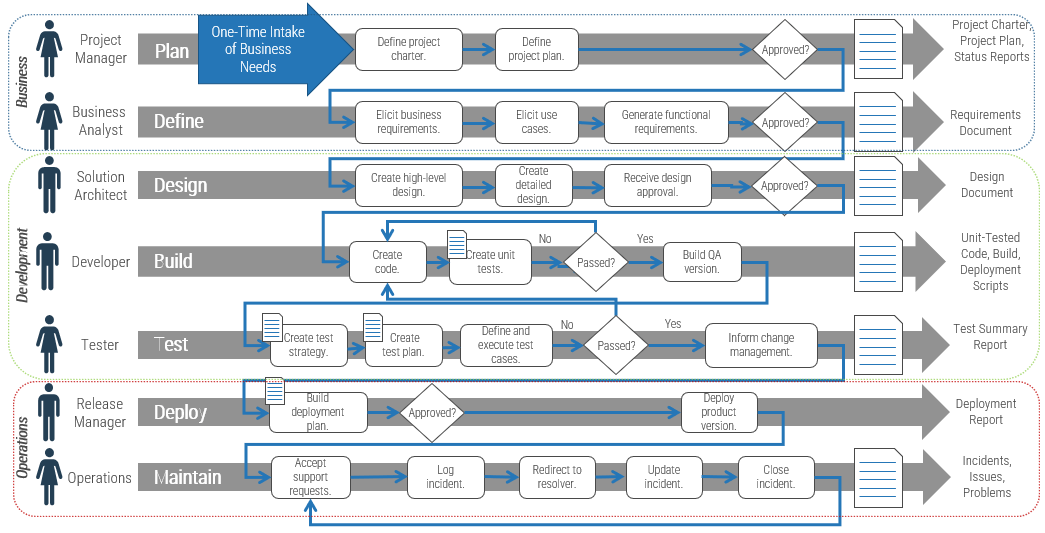
- Business is separated from the delivery of technology it needs. Only one-third of the product is actually valuable (ITRG, N=40,000).
- In Waterfall, a team of experts in specific disciplines hand off different aspects of the lifecycle.
- Document sign-offs are required to ensure integration between silos (Business, Development, and Operations) and individuals.
- A separate change-request process lays over the entire lifecycle to prevent changes from disrupting delivery.
- Tools are deployed to support a specific role (e.g. BA) and seldom integrated (usually requirements <-> test).
Wagile/Agifall/WaterScrumFall SDLC
Valuable product delivered in multiple releases
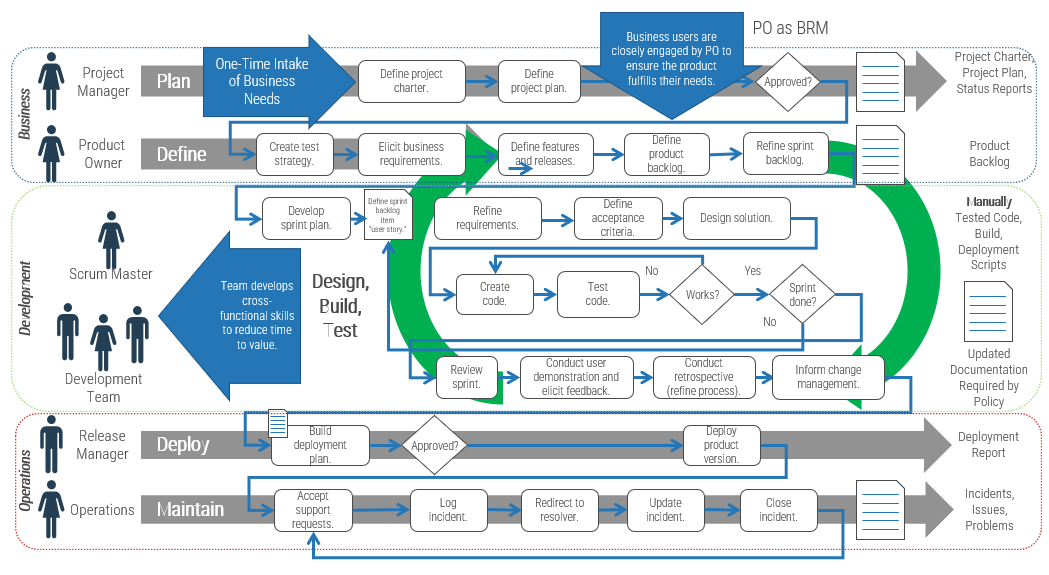
- Business is more closely integrated by a business product owner, who is accountable for day-to-day delivery of value for users.
- The team collaborates and develops cross-functional skills as they define, design, build, and test code over time.
- Sign-offs are reduced but documentation is still focused on satisfying project delivery and operations policy requirements.
- Change is built into the process to allow the team to respond to change dynamically.
- Tools start to be integrated to streamline delivery (usually requirements and Agile work management tools).
Agile SDLC
Valuable product delivered iteratively: frequency depends Ops' capacity
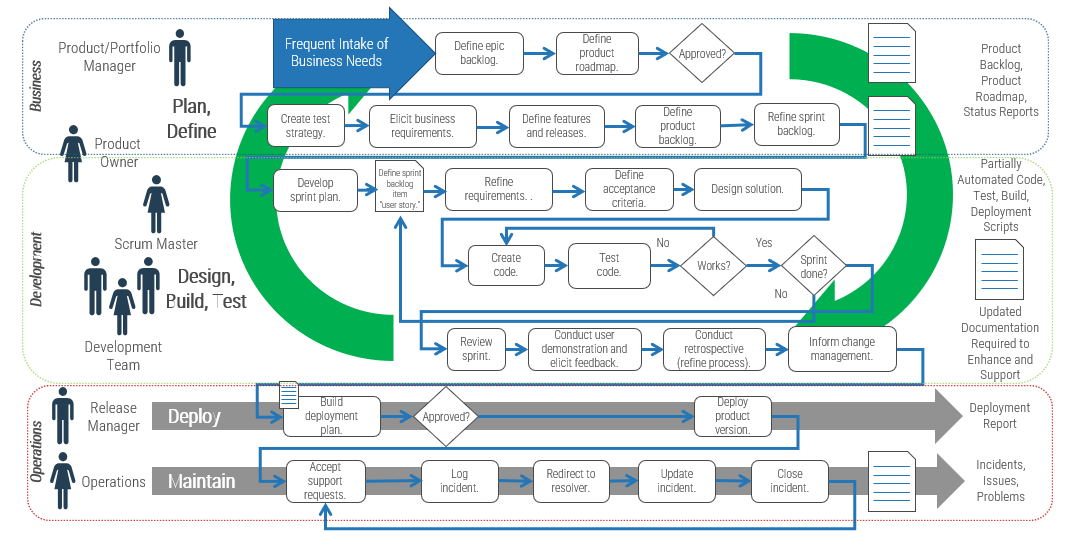
- Business users are closely integrated through regularly scheduled demos (e.g. every two weeks).
- Team is fully cross-functional and collaborates to plan, define, design, build, and test the code, supported by specialists.
- Documentation is focused on future development and operations needs.
- Change is built into the process to allow the team to respond to change dynamically.
- Automation is explored for application development (e.g. automated regression testing).
Agile With DevOps SDLC
High frequency iterative delivery of valuable product (e.g. every two weeks)
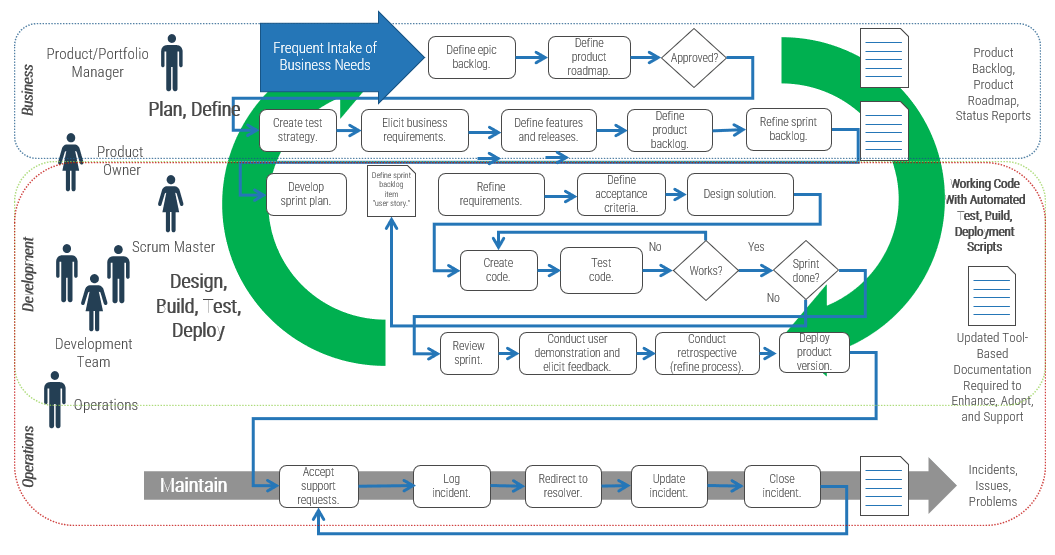
- Business users are closely integrated through regularly scheduled demos.
- Development and operations teams collaborate to plan, define, design, build, test, and deploy code, supported by automation.
- Documentation is focused on supporting users, future changes, and operational support.
- Change is built into the process to allow the team to respond to change dynamically.
- Test, build, deploy process is fully automated. (Service desk is still separated.)
DevOps SDLC
Continuous integration and delivery
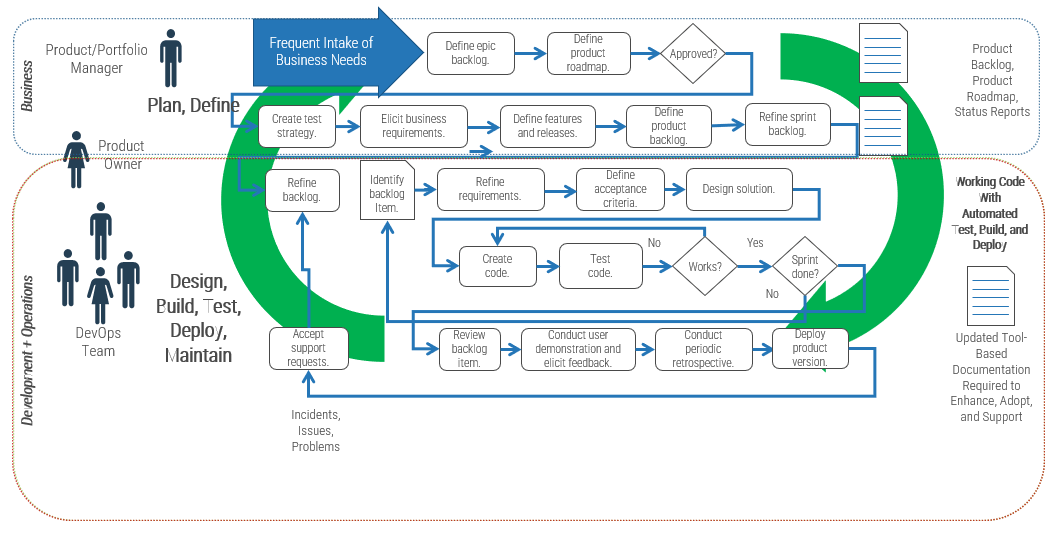
- Business users are closely integrated through regularly scheduled demos.
- Fully integrated DevOps team collaborates to plan, define, design, build, test, deploy, and maintain code.
- Documentation is focused on future development and use adoption.
- Change is built into the process to allow the team to respond to change dynamically.
- Development and operations toolchain are fully integrated.
Fully integrated product SDLC
Agile + DevOps + continuous delivery of valuable product on demand
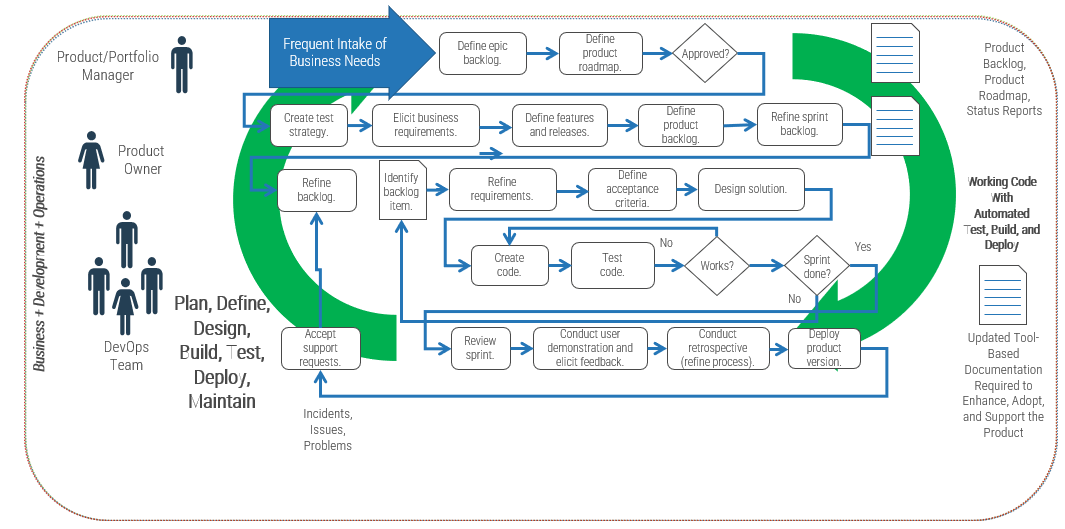
- Business users are fully integrated with the teams through dedicated business product owner.
- Cross-functional teams collaborate across the business and technical life of the product.
- Documentation supports internal and external needs (business, users, operations).
- Change is built into the process to allow the team to respond to change dynamically.
- Toolchain is fully integrated (including service desk).
Appendix C: Understanding Agile Scrum Practices and Ceremonies
Cultural advantages of Agile
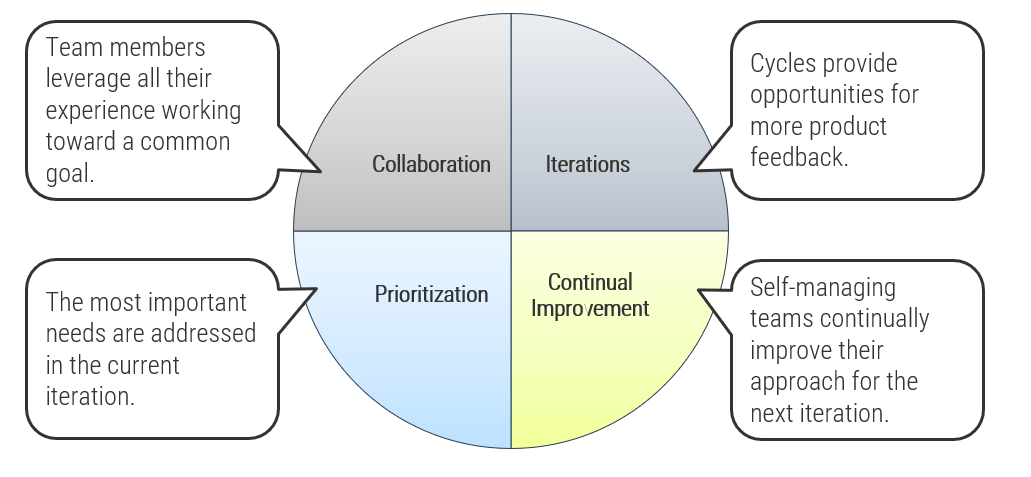
Agile* SDLC
With shared ownership instead of silos, we are able to deliver value at the end of every iteration (aka sprint)
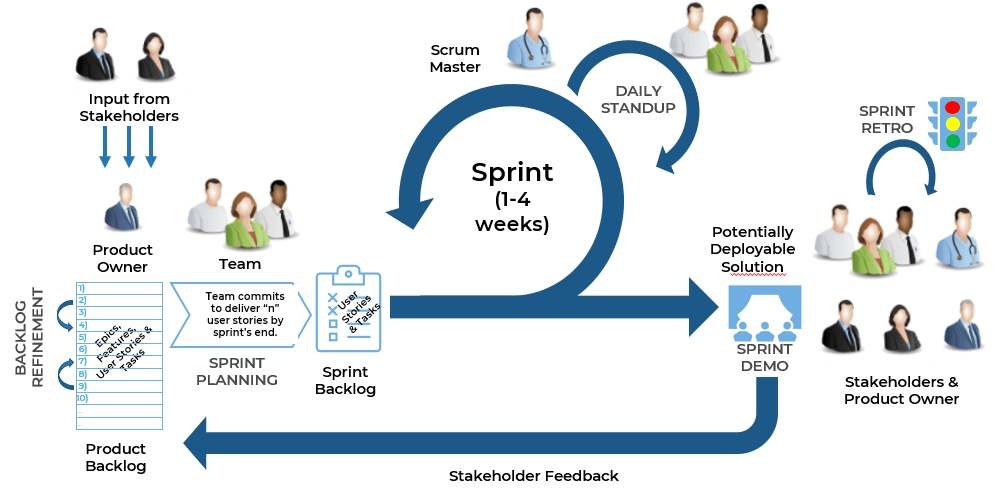
Key Elements of the Agile SDLC
- You are not "one and done." There are many short iterations with constant feedback.
- There is an empowered product owner. This is a single authoritative voice who represents stakeholders.
- There is a fluid product backlog. This enables prioritization of requirements "just-in-time."
- There is a cross-functional, self-managing team. This team makes commitments and is empowered by the organization to do so.
- There is working, tested code at the end of each sprint: Value becomes more deterministic along sprint boundaries.
- Stakeholders are allowed to see and use the functionality and provide necessary feedback.
- Feedback is being continuously injected back into the product backlog. This shapes the future of the solution.
- There is continuous improvement through sprint retrospectives.
- The virtuous cycle of sprint-demo-feedback is internally governed when done right.
* There are many Agile methodologies to choose from, but Scrum is by far the most widely used (and is shown above).
Understand the Scrum process
The scrum process coordinates multiple stakeholders to deliver on business priorities.
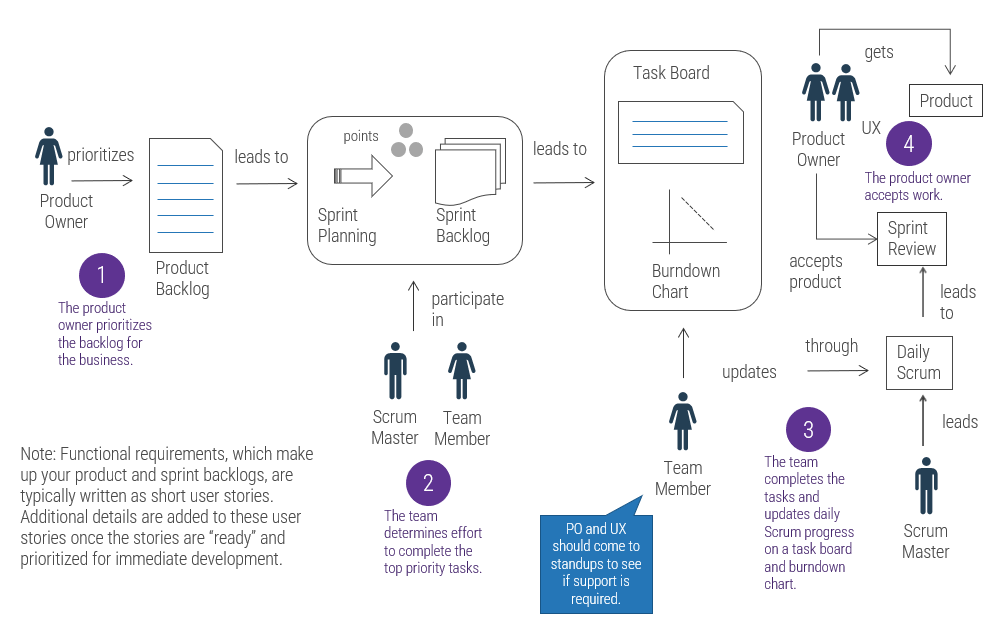
Understand the ceremonies part of the scrum process
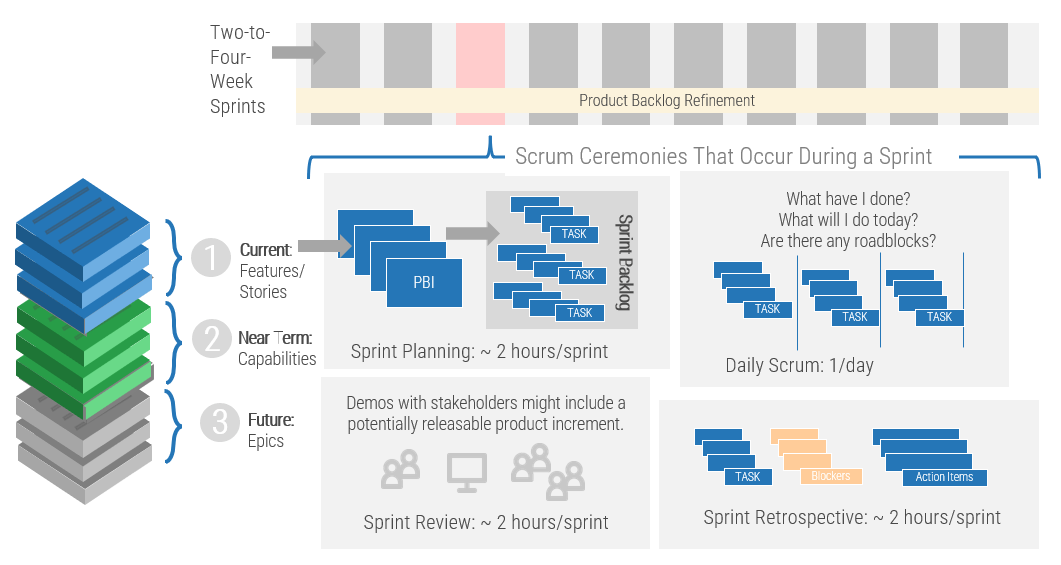
Scrum vs. Kanban: Key differences
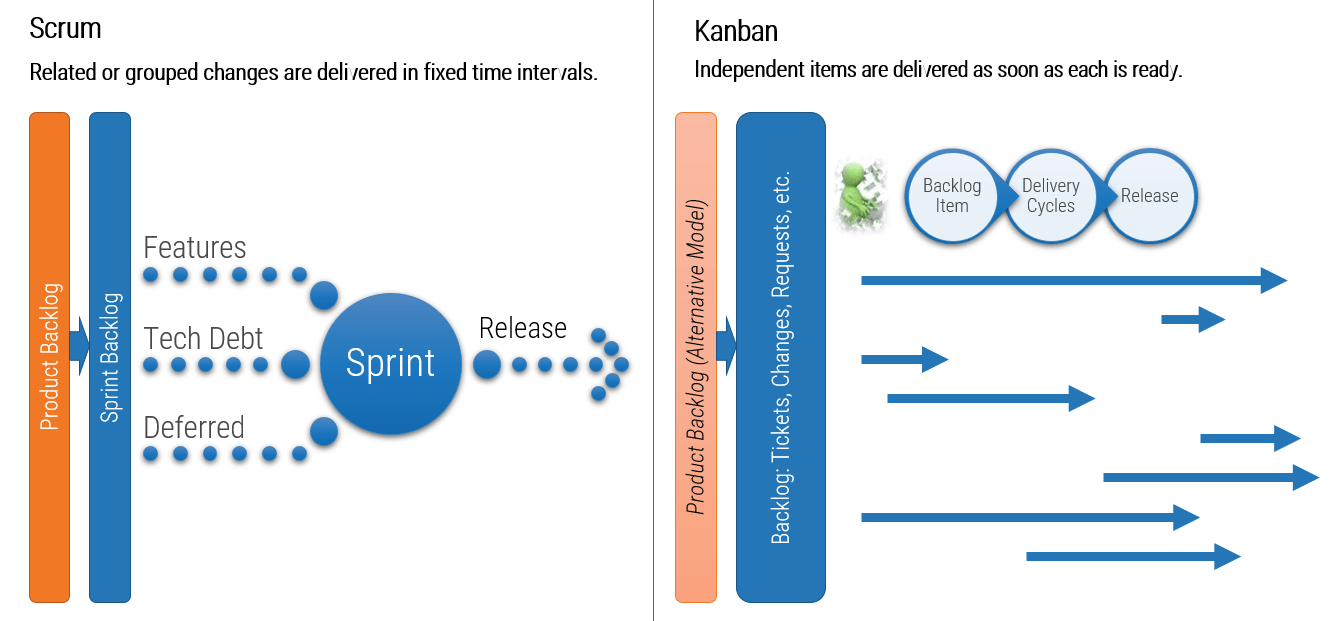
Scrum vs. Kanban: When to use each
Scrum
Related or grouped changes are delivered in fixed time intervals.
Use when:
- Coordinating the development or release of related items
- Maturing a product or service
- Coordinating interdependencies between work items
Kanban
Independent items are delivered as soon as each is ready.
Use when:
- Completing work items from ticketing or individual requests
- Completing independent changes
- Releasing changes as soon as possible
Appendix D: Improving Product Management
Product delivery realizes value for your product family
While planning and analysis are done at the family level, work and delivery are done at the individual product level.
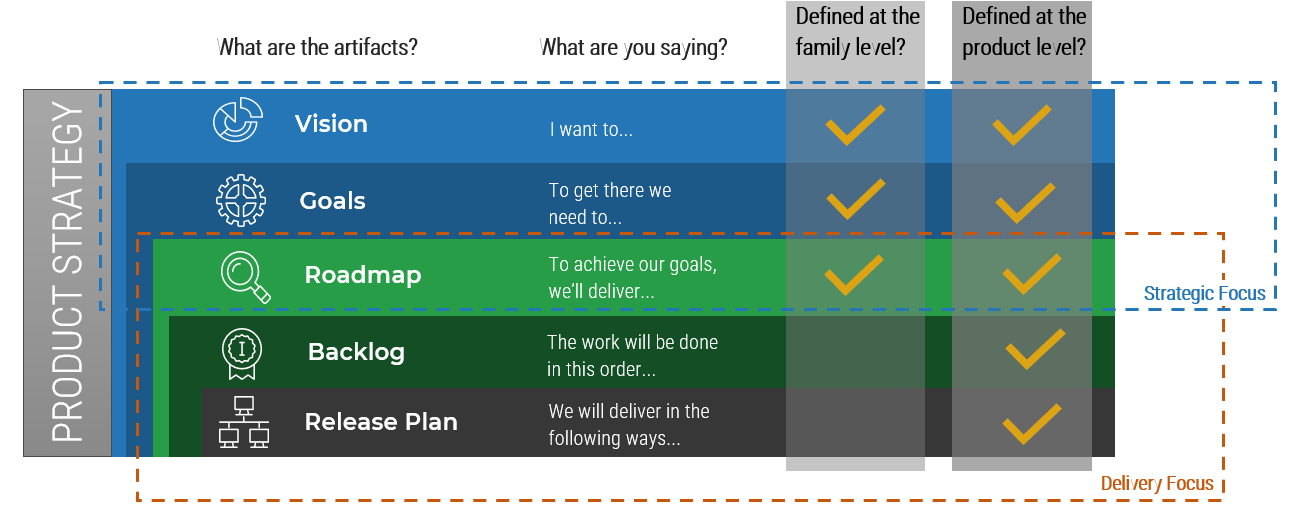
Manage and communicate key milestones
Successful product-delivery managers understand and define key milestones in their product-delivery lifecycles. These milestones need to be managed along with the product backlog and roadmap.
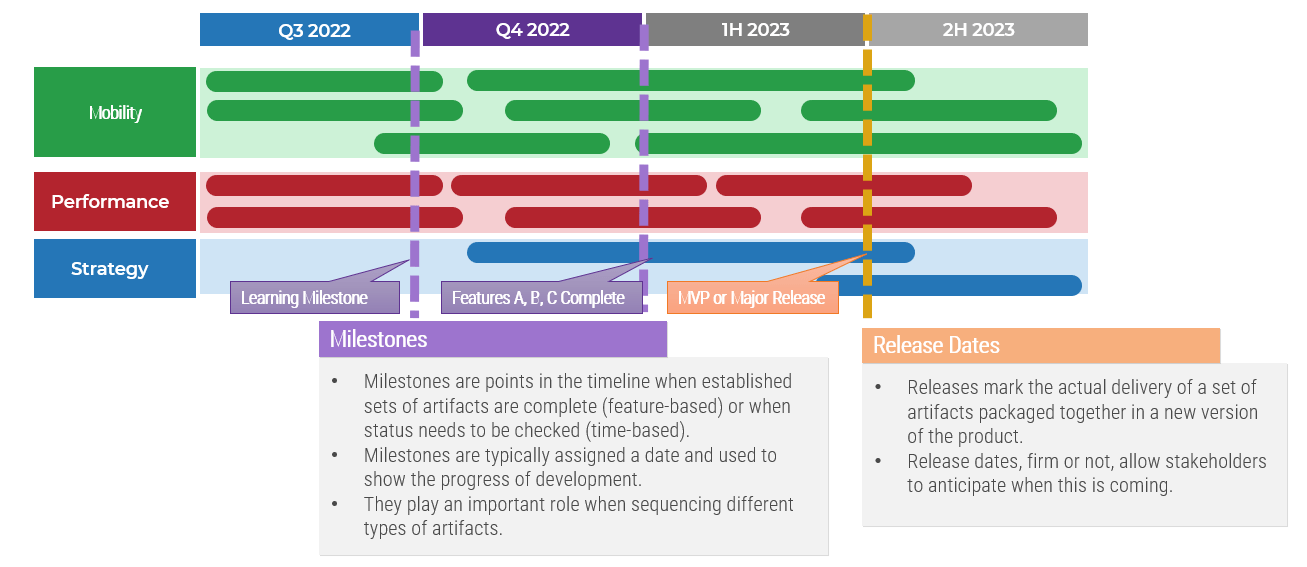
Info-Tech Best Practice
Product management is not just about managing the product backlog and development cycles.
Teams need to manage key milestones, such as learning milestones, test releases, product releases, phase gates, and other organizational checkpoints.
A backlog stores and organizes product backlog items (PBIs) at various stages of readiness
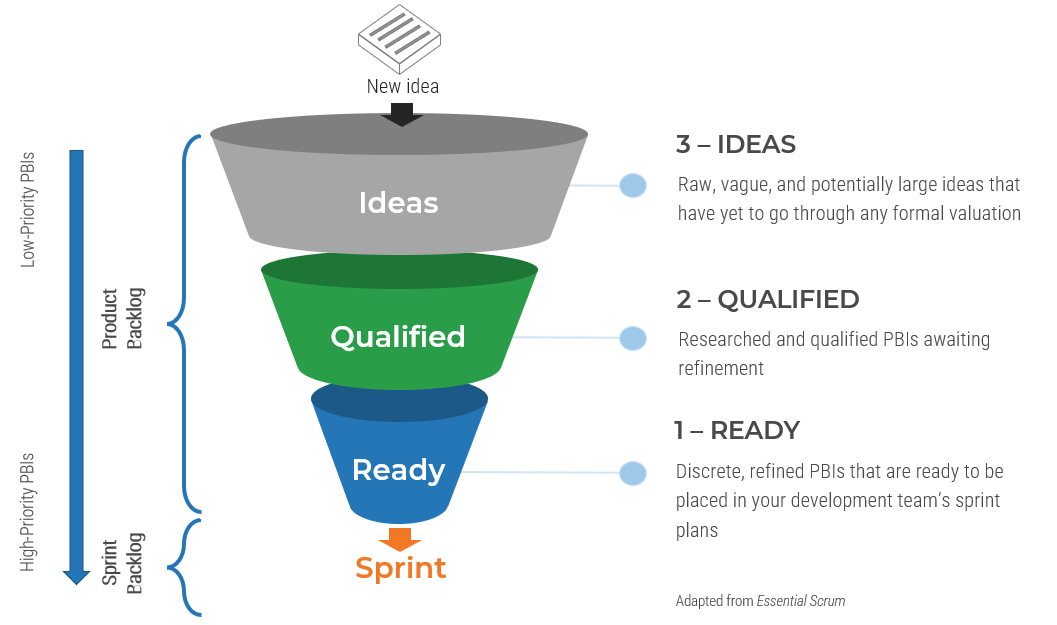
A well-formed backlog can be thought of as a DEEP backlog:
Detailed Appropriately: PBIs are broken down and refined as necessary.
Emergent: The backlog grows and evolves over time as PBIs are added and removed.
Estimated: The effort that a PBI requires is estimated at each tier.
Prioritized: A PBI's value and priority are determined at each tier.
Source: Perforce, 2018
Backlog tiers facilitate product planning steps
Ranging from the intake of an idea to a PBI ready for development; to enter the backlog, each PBI must pass through a given quality filter.
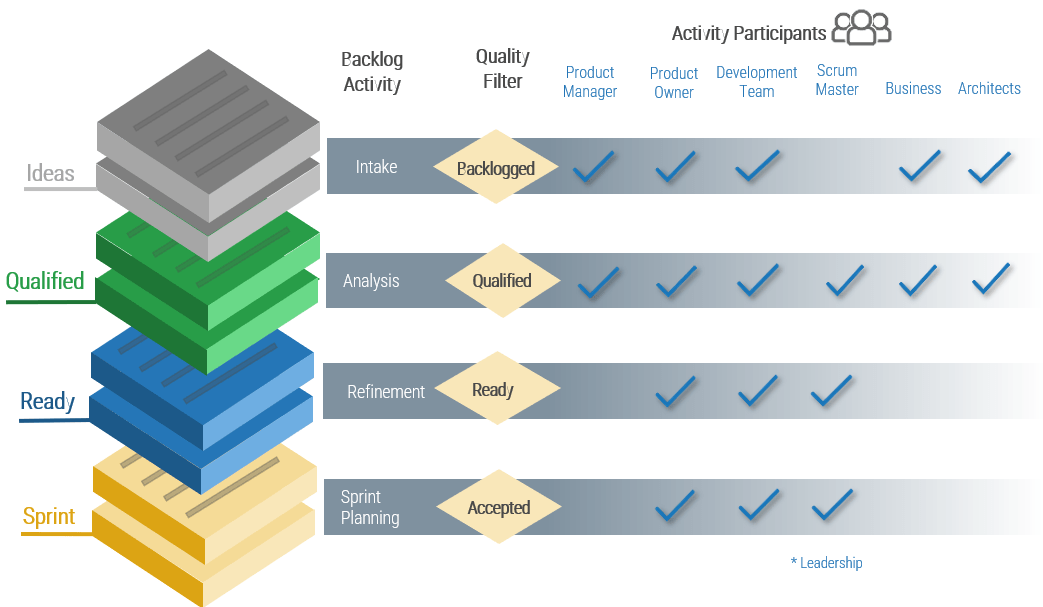
Each activity is a variation of measuring value and estimating effort in order to validate and prioritize a PBI.
A PBI successfully completes an activity and moves to the next backlog tier when it meets the appropriate criteria. Quality filters should exist between each tier.
Use quality filters to ensure focus on the most important PBIs
Expand the concepts of defining "ready" and "done" to include the other stages of a PBI's journey through product planning.
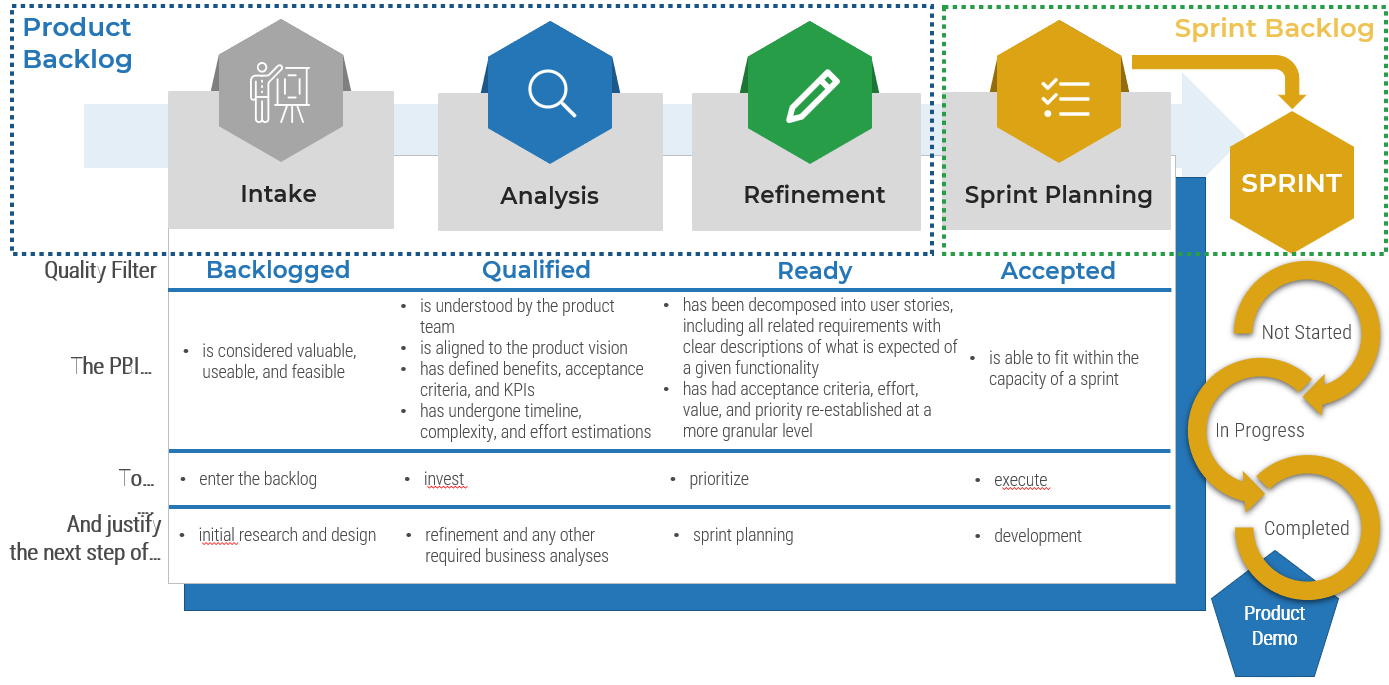
Info-Tech Best Practice
A quality filter ensures that quality is met and the appropriate teams are armed with the correct information to work more efficiently and improve throughput.
Define product value by aligning backlog delivery with roadmap goals
In each product plan, the backlogs show what you will deliver. Roadmaps identify when and in what order you will deliver value, capabilities, and goals.
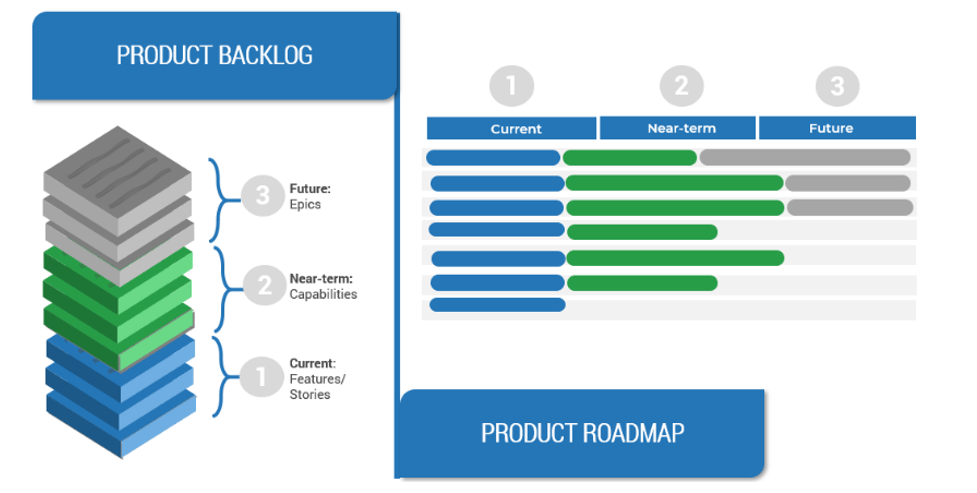
Product roadmaps guide delivery and communicate your strategy
In "Deliver on Your Digital Product Vision," we demonstrate how a product roadmap is core to value realization. The product roadmap is your communicated path. As a product owner, you use it to align teams and changes to your defined goals, as well as your product to enterprise goals and strategy.
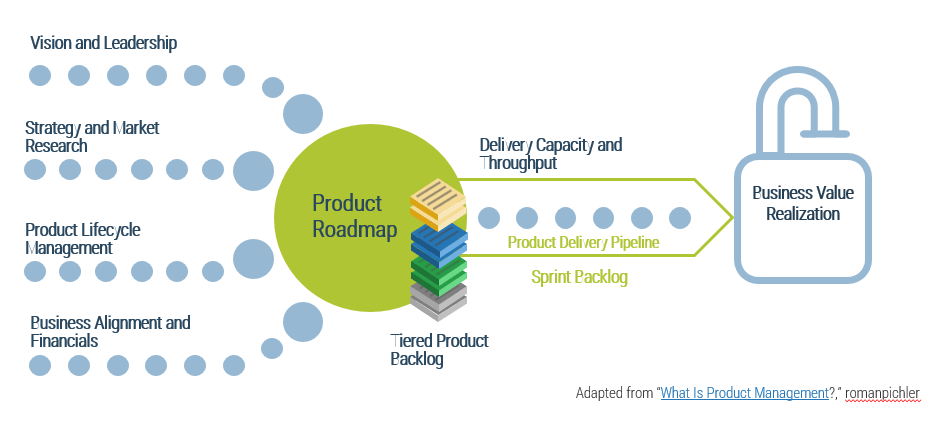
Info-Tech Insight
The quality of your product backlog - and your ability to realize business value from your delivery pipeline - is directly related to the input, content, and prioritization of items in your product roadmap.
Info-Tech's approach
Operationally align product delivery to enterprise goals
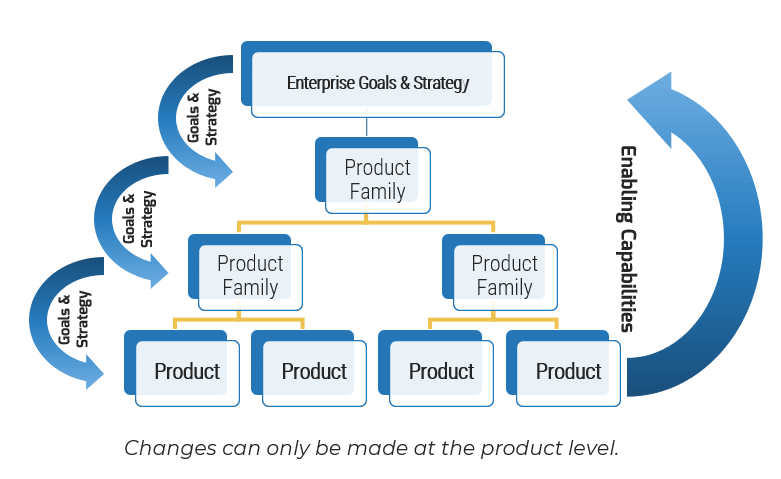
The Info-Tech Difference
Create a common definition of what a product is and identify the products in your inventory.
Use scaling patterns to build operationally aligned product families.
Develop a roadmap strategy to align families and products to enterprise goals and priorities.
Use products and families to assess value realization.
Buying Options
Decide if You Are Ready for SAFe
IT Risk Management · IT Leadership & Strategy implementation · Operational Management · Service Delivery · Organizational Management · Process Improvements · ITIL, CORM, Agile · Cost Control · Business Process Analysis · Technology Development · Project Implementation · International Coordination · In & Outsourcing · Customer Care · Multilingual: Dutch, English, French, German, Japanese · Entrepreneur
Tymans Group is a brand by Gert Taeymans BV
Gert Taeymans bv
Europe: Koning Albertstraat 136, 2070 Burcht, Belgium — VAT No: BE0685.974.694 — phone: +32 (0) 468.142.754
USA: 4023 KENNETT PIKE, SUITE 751, GREENVILLE, DE 19807 — Phone: 1-917-473-8669
Copyright 2017-2022 Gert Taeymans BV
